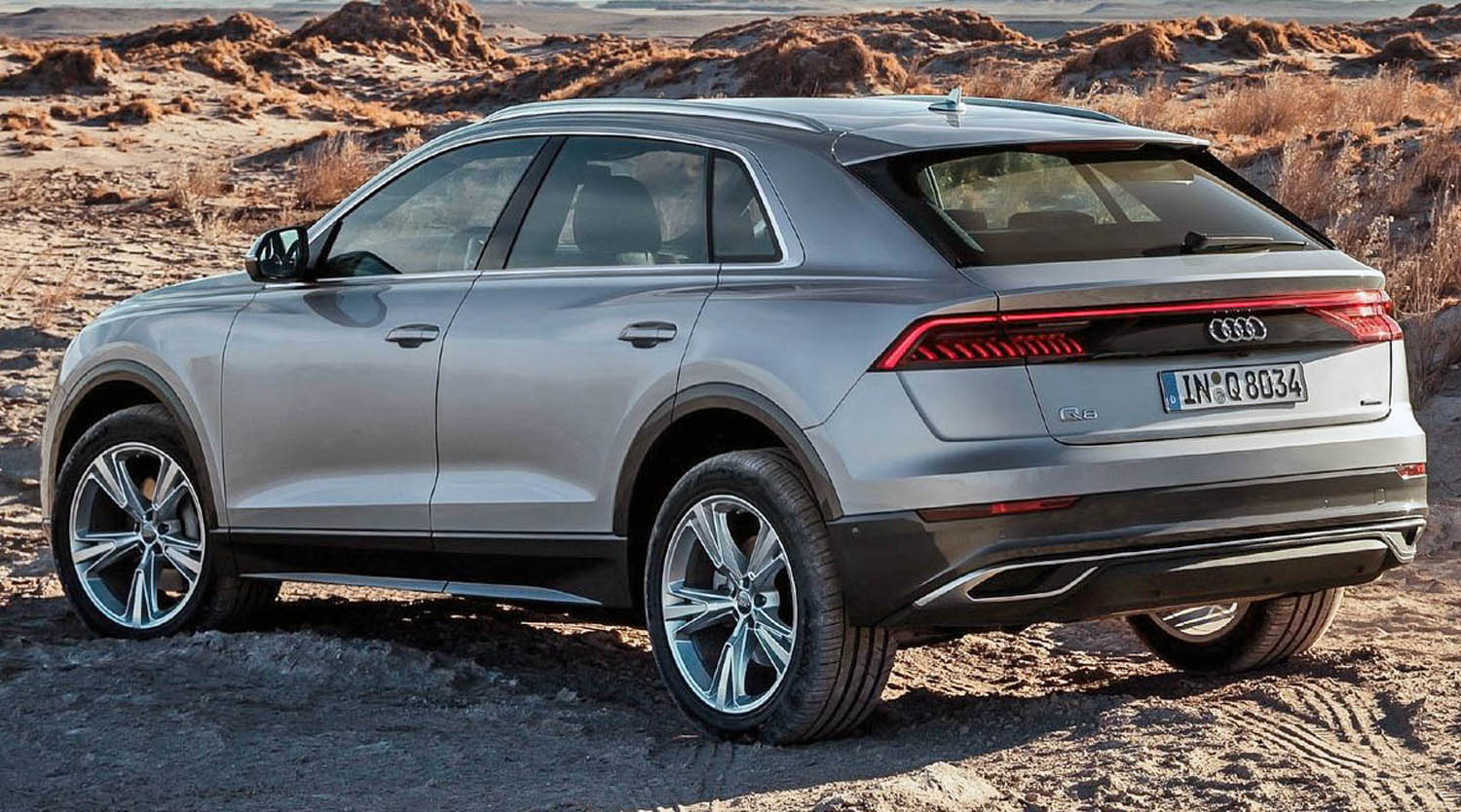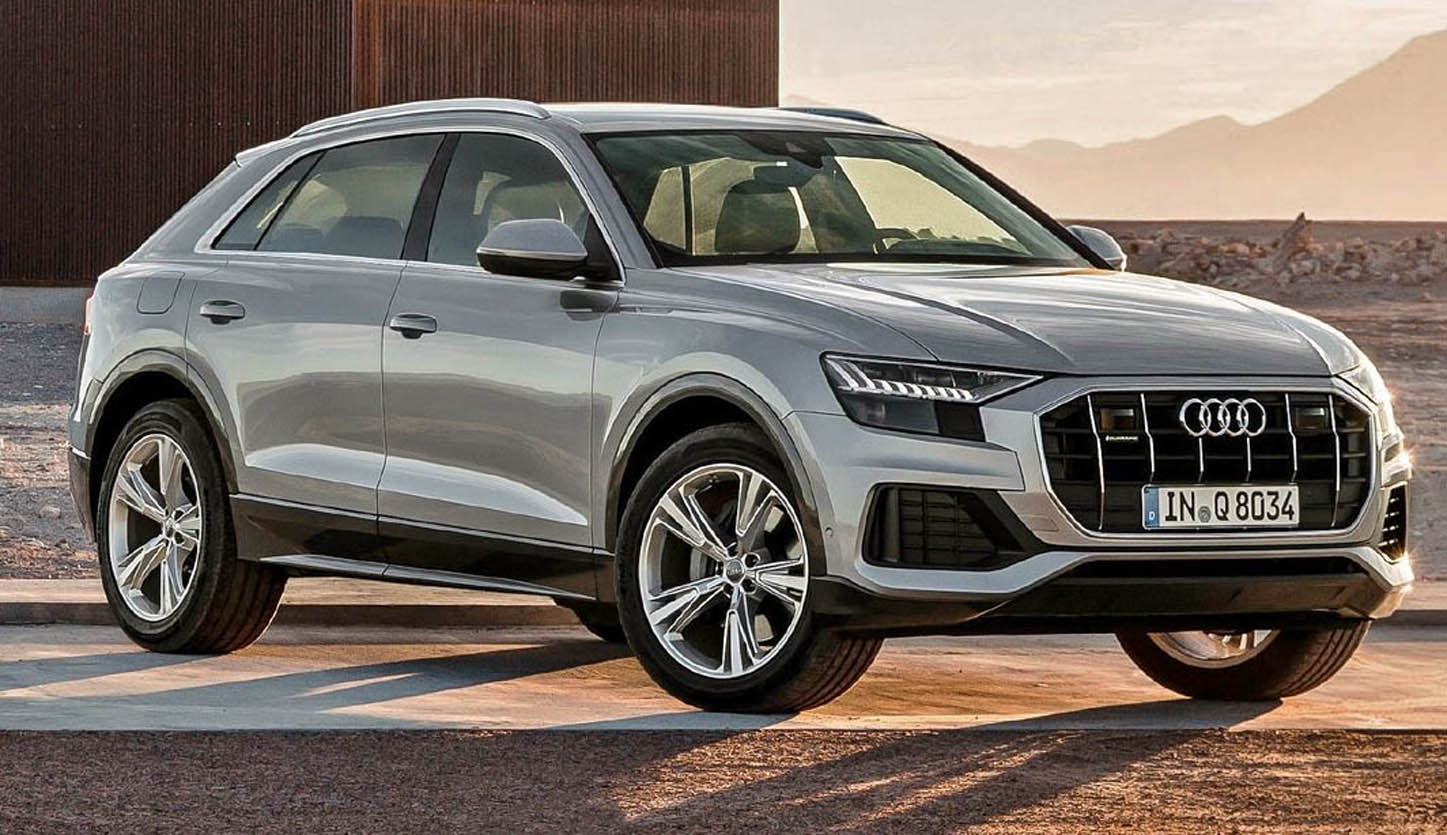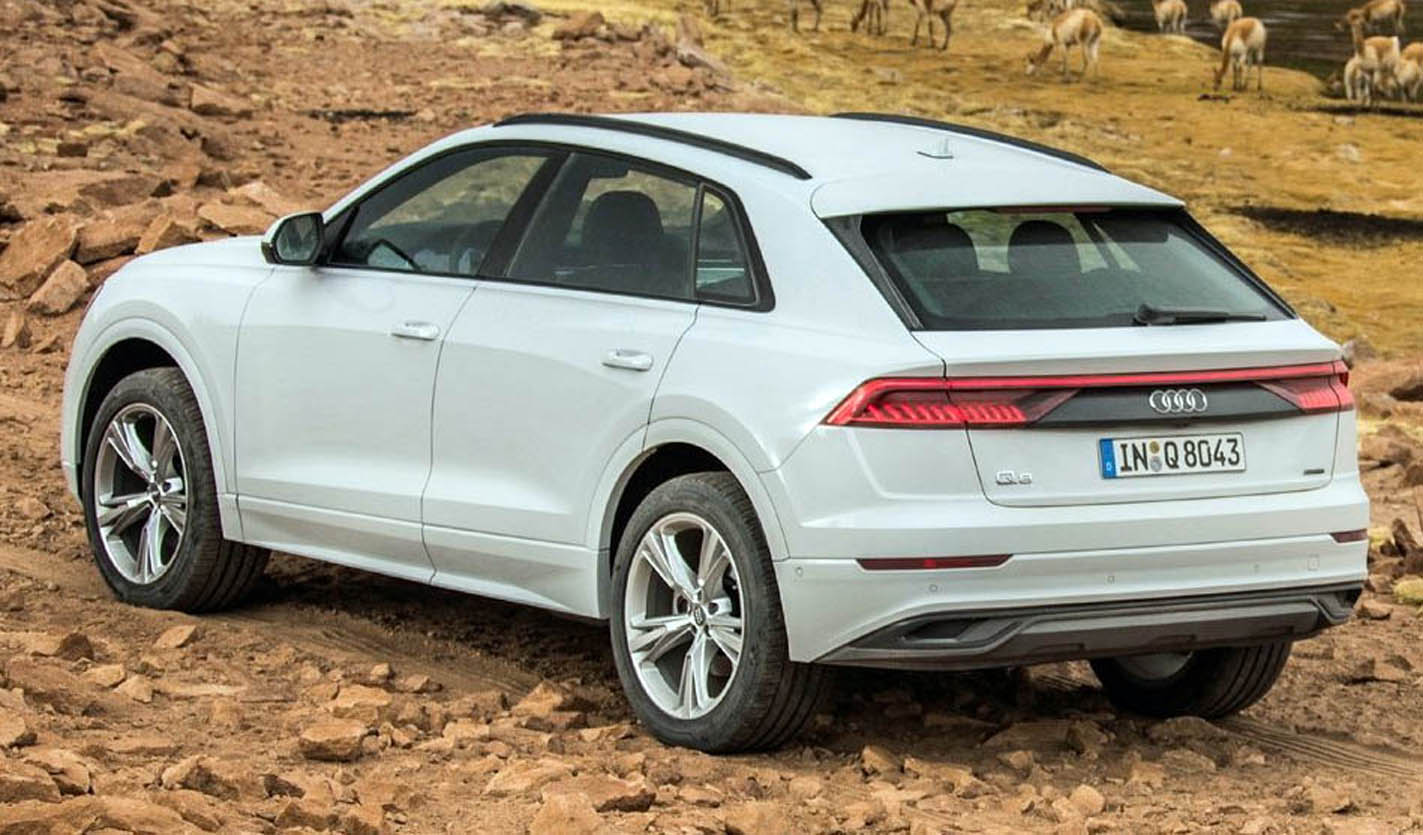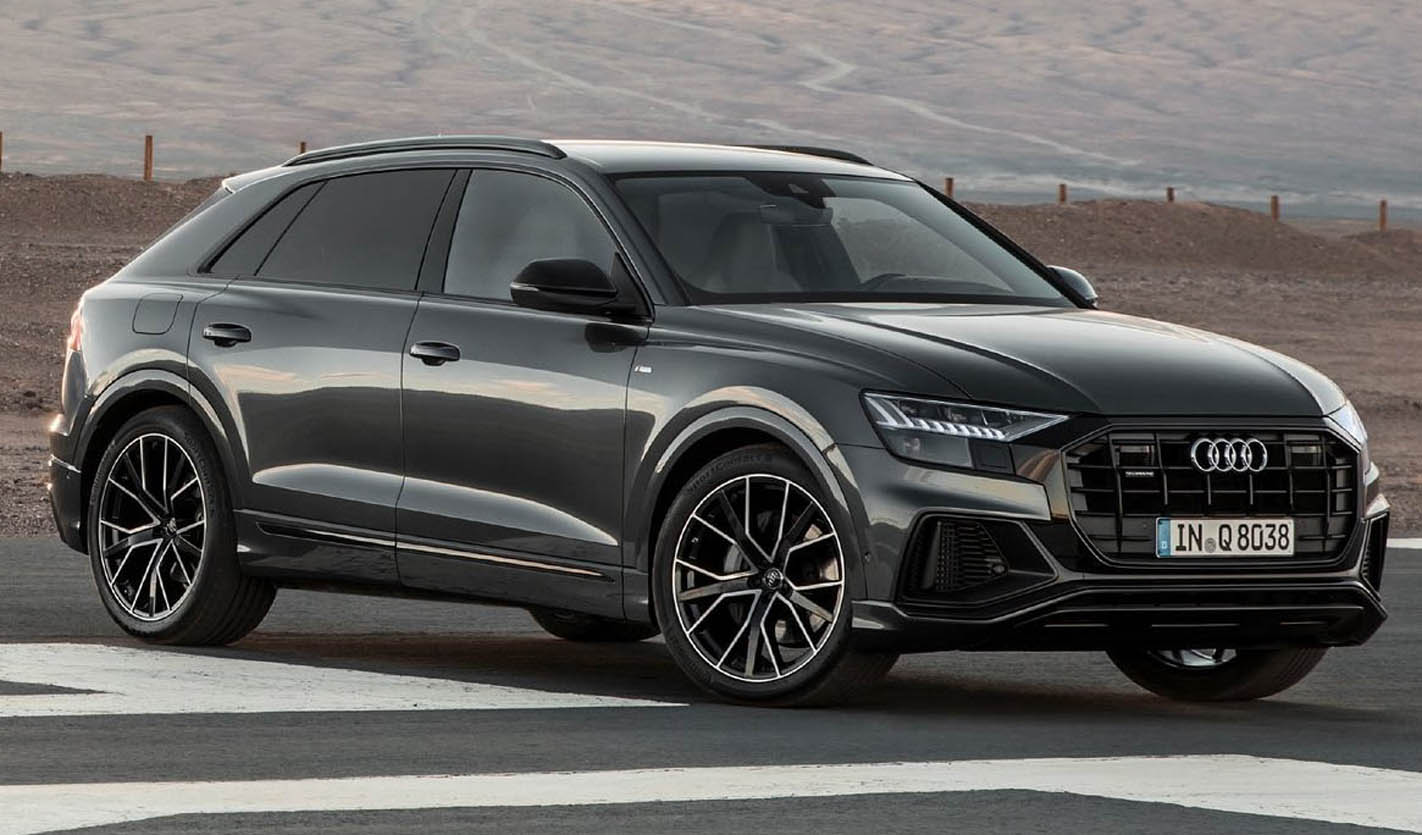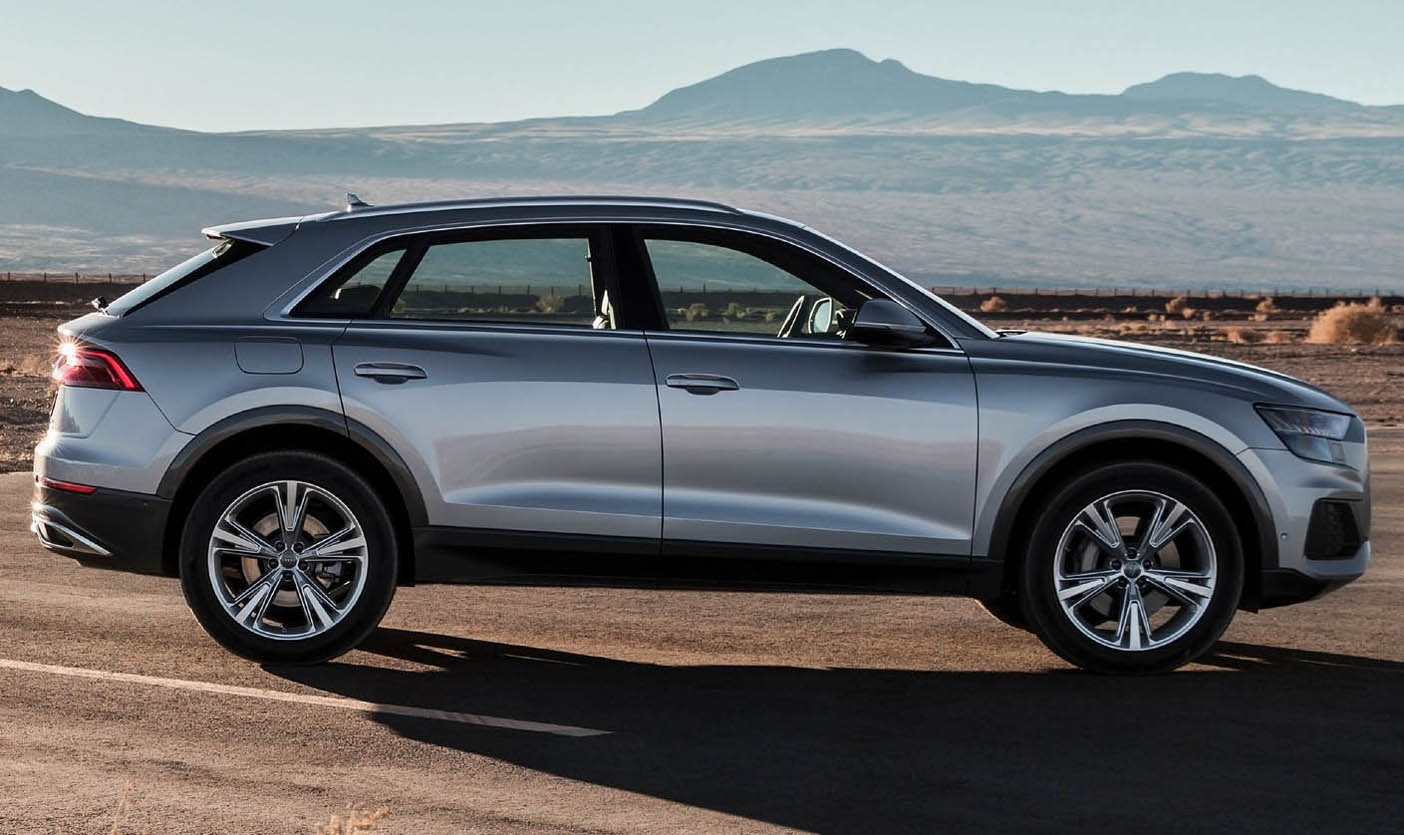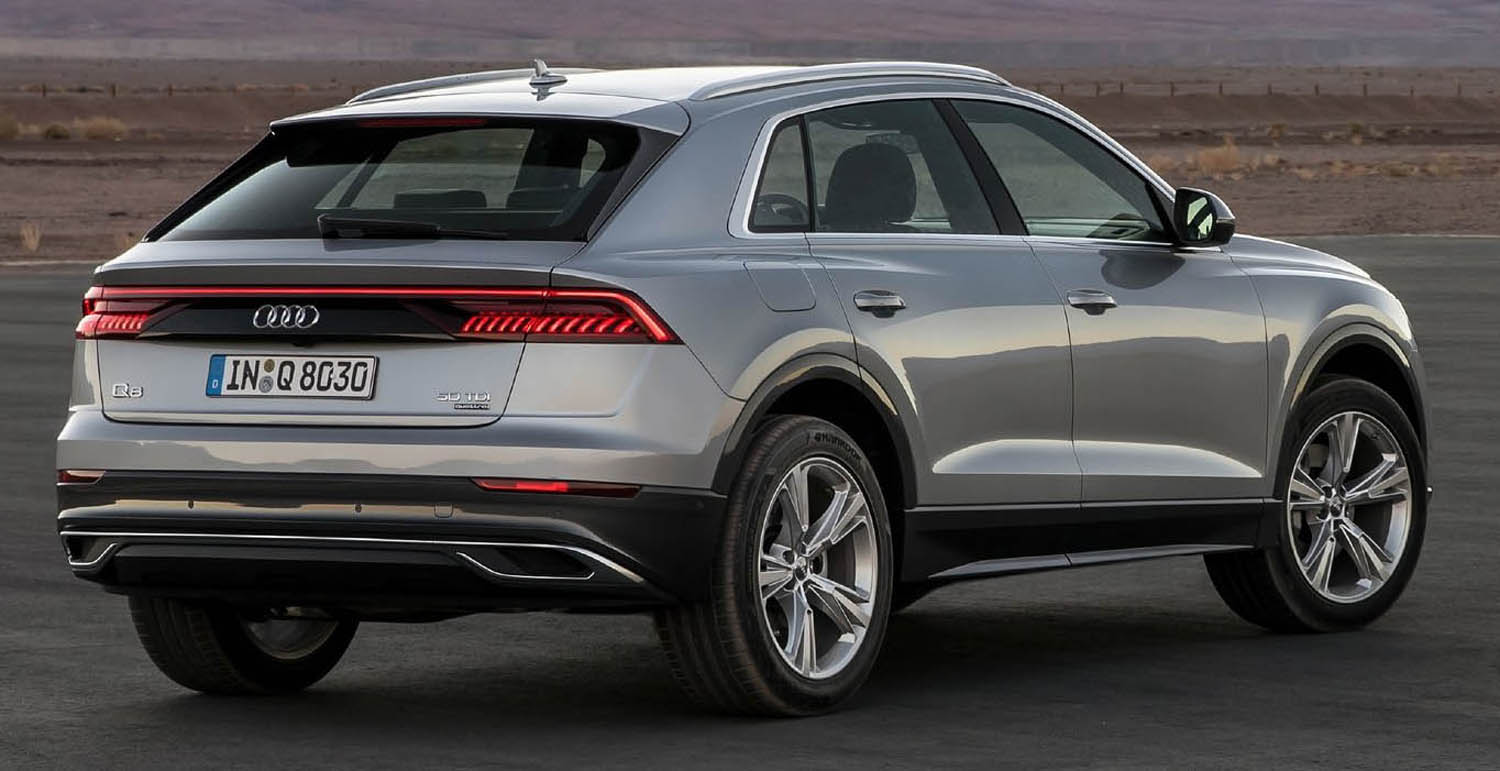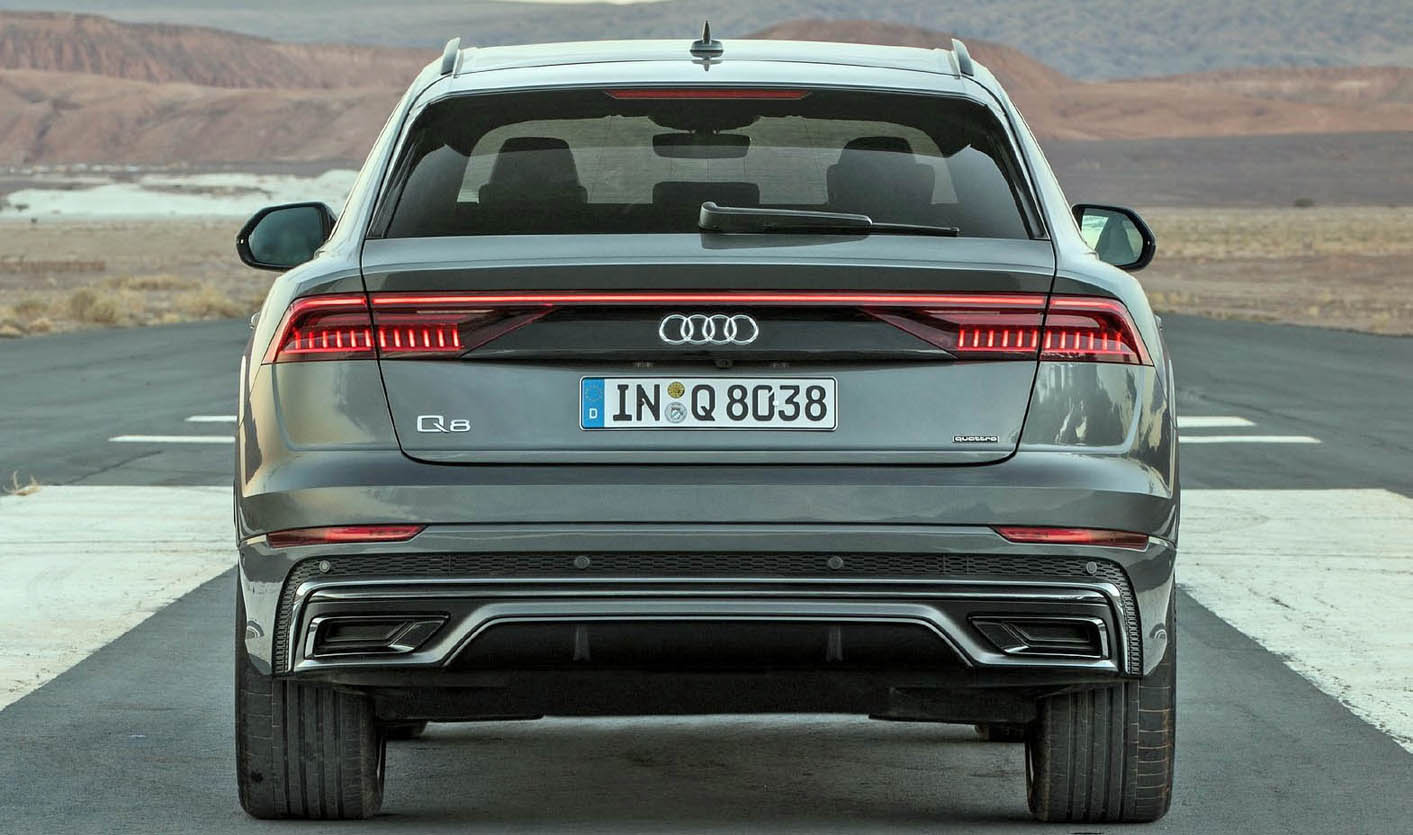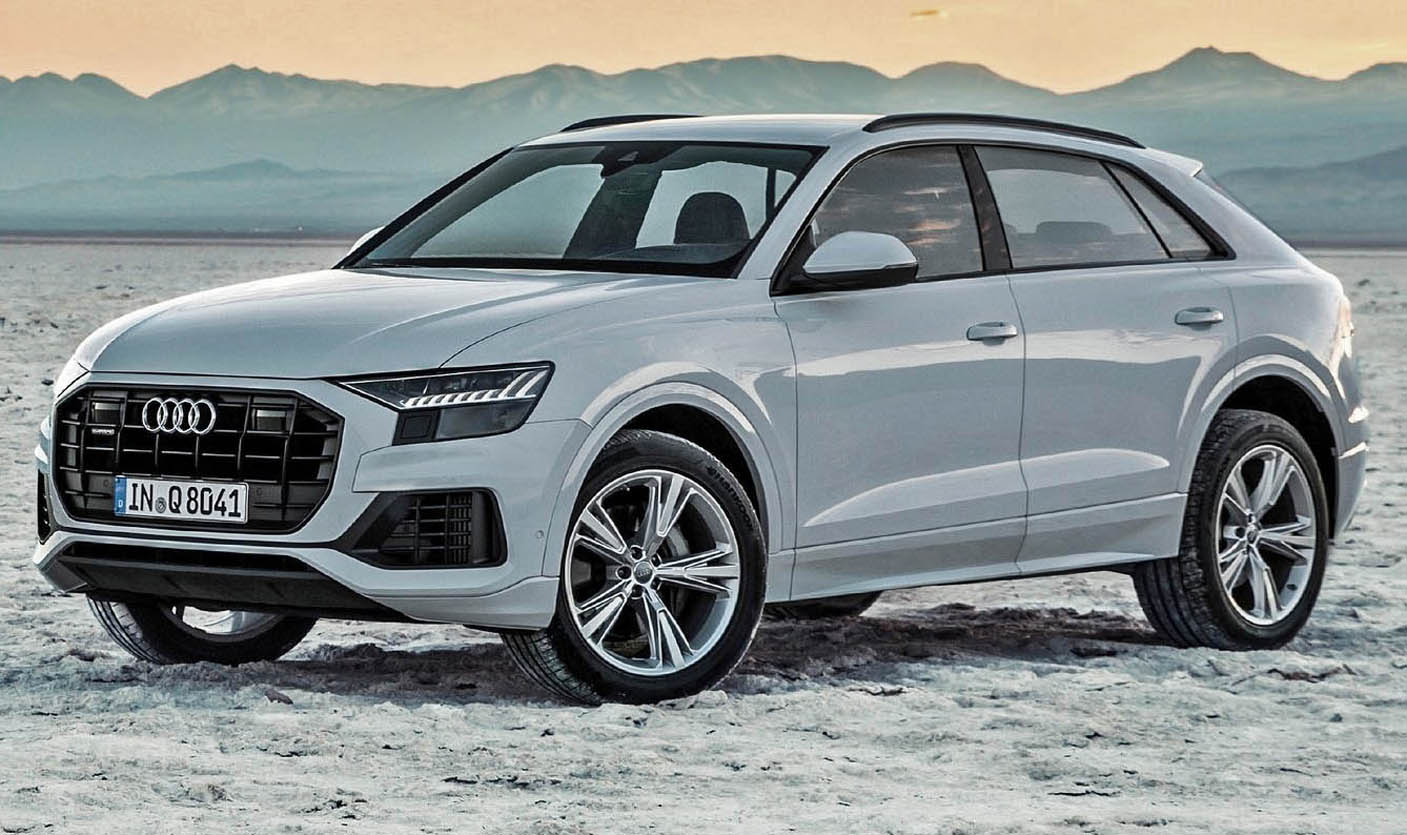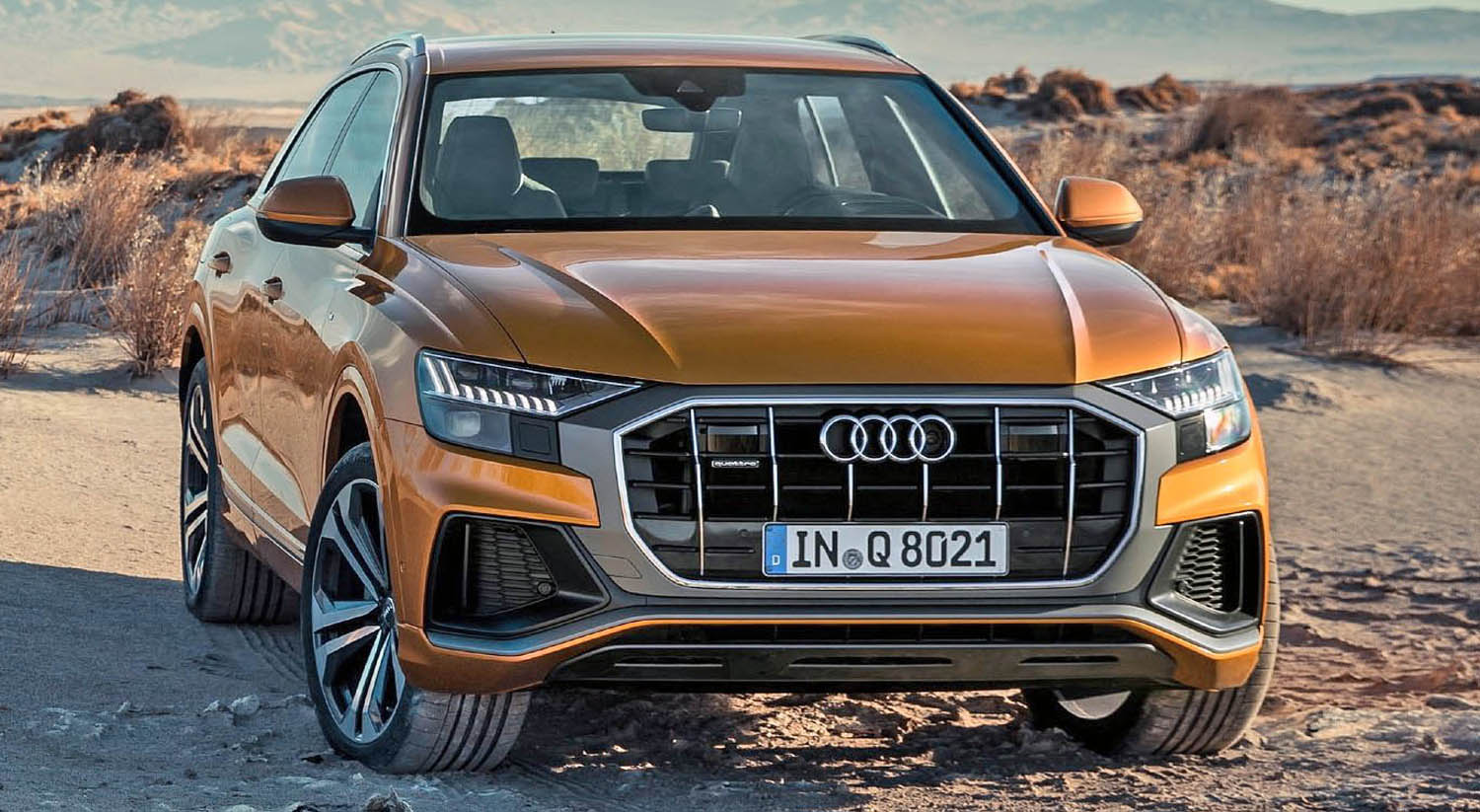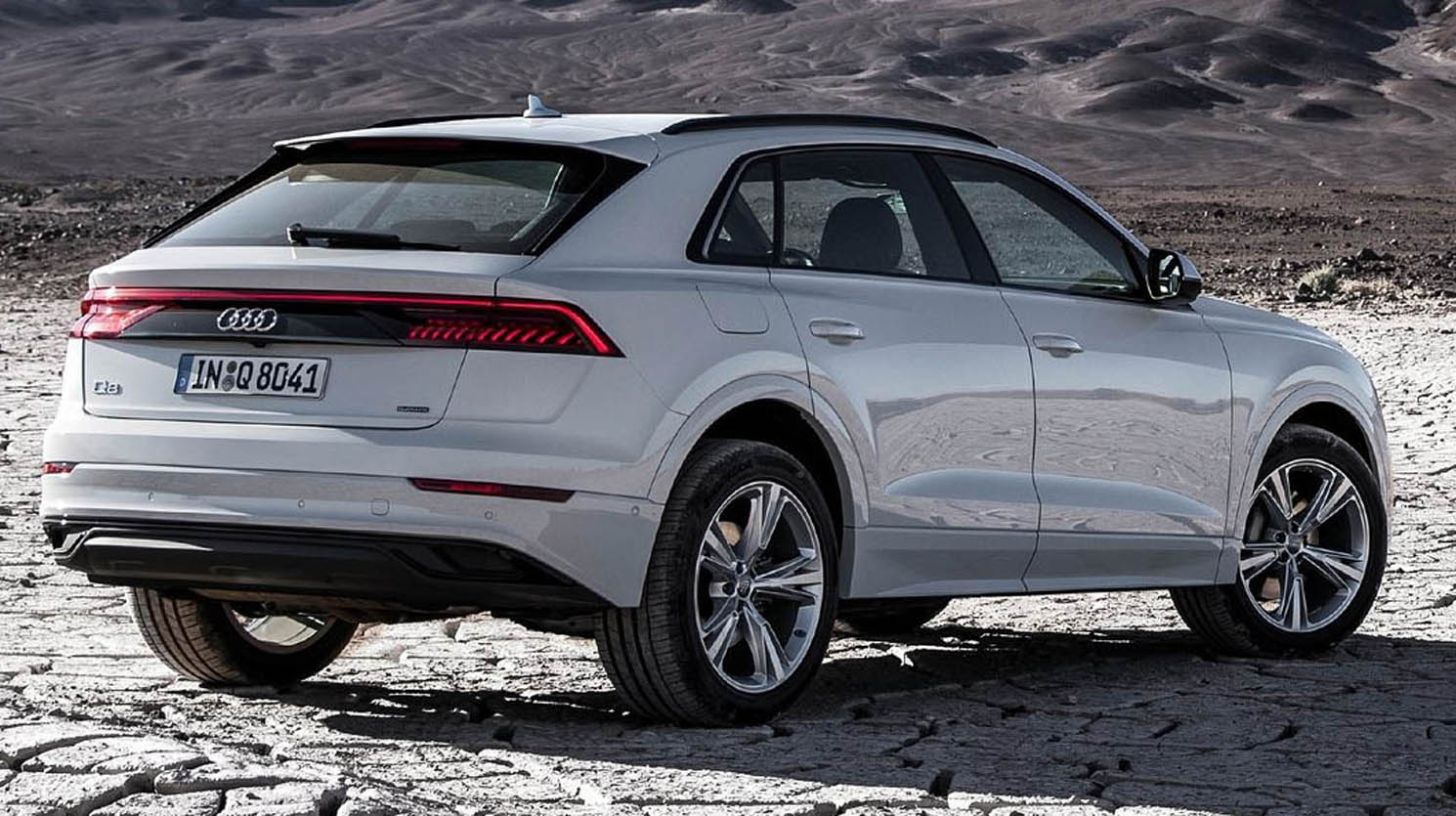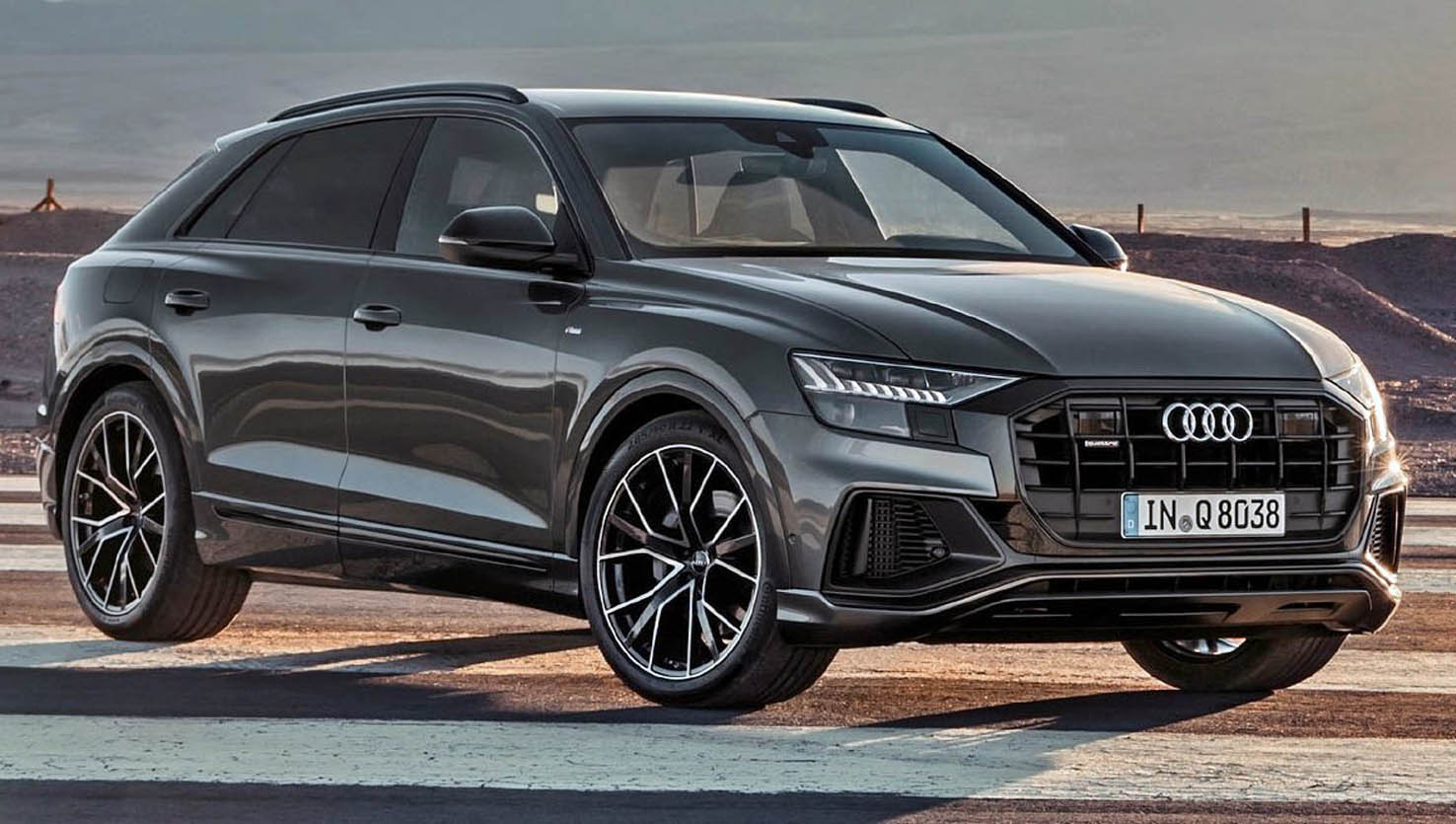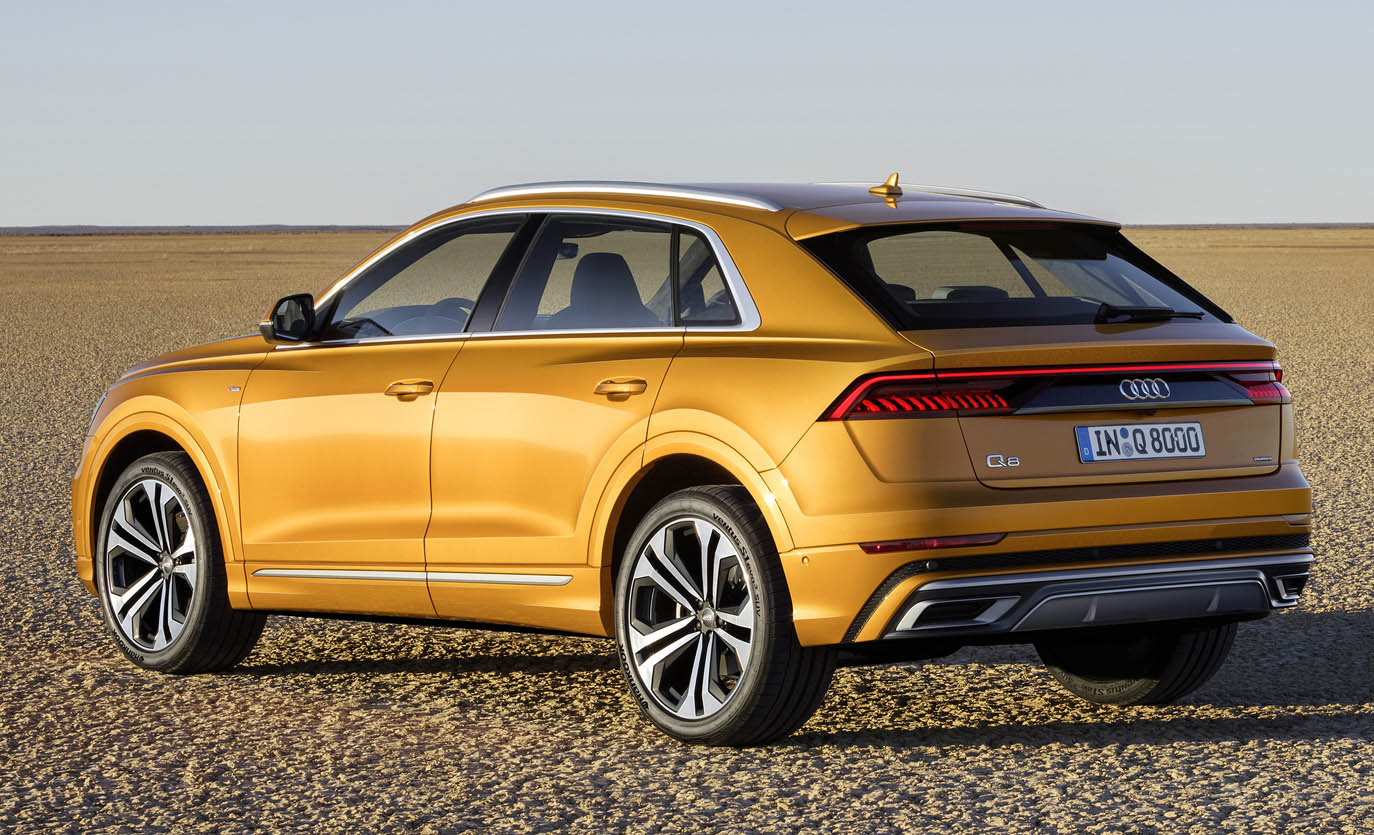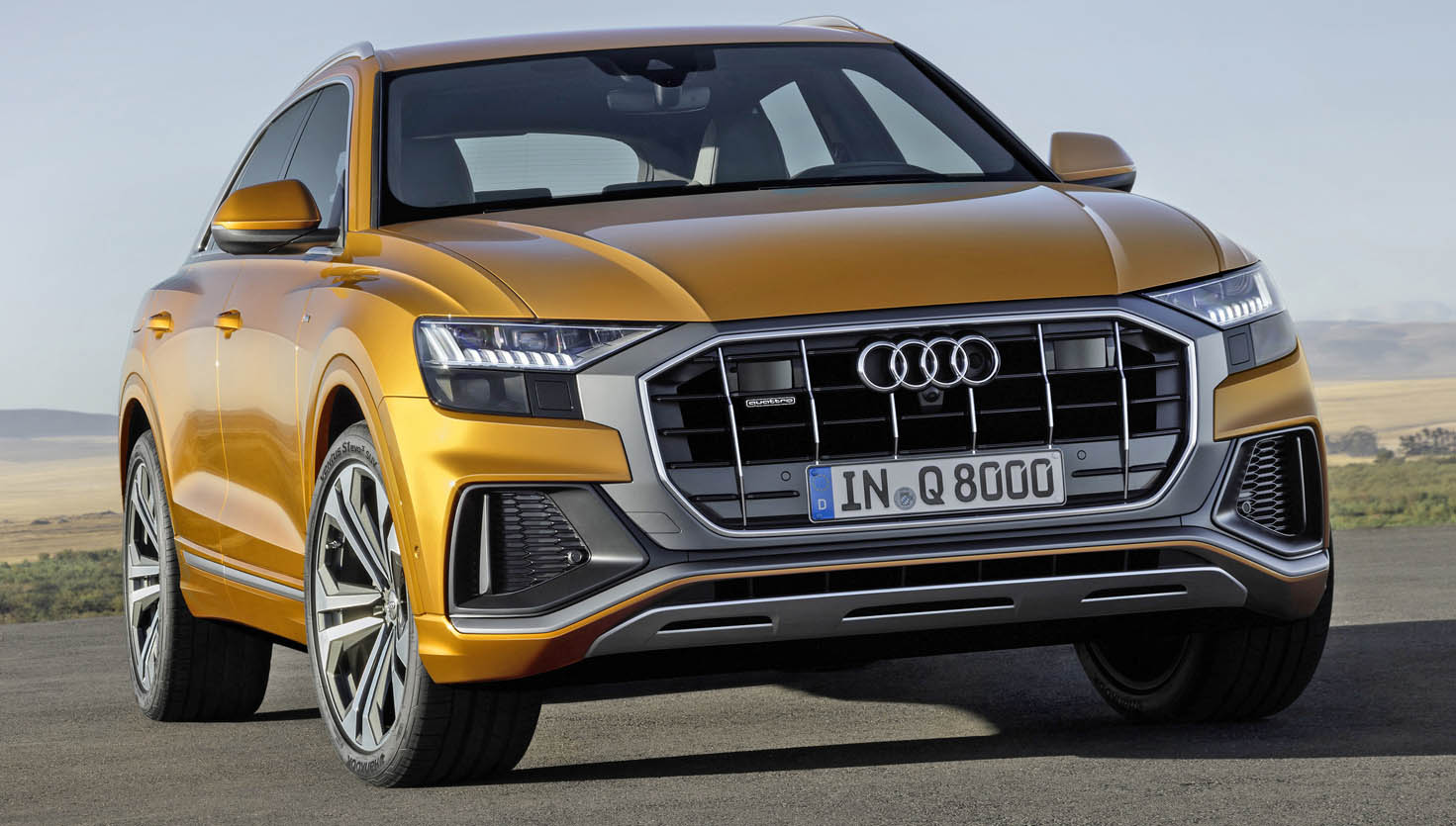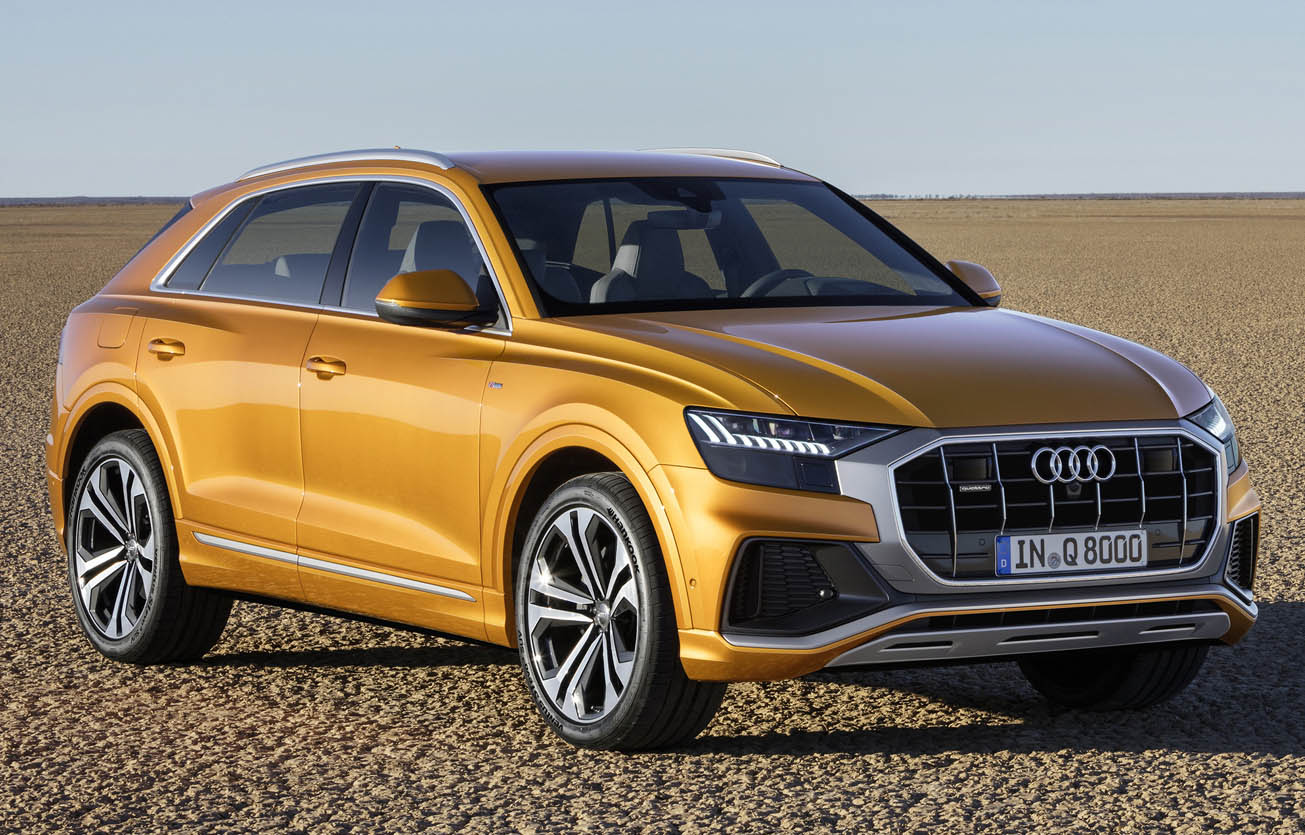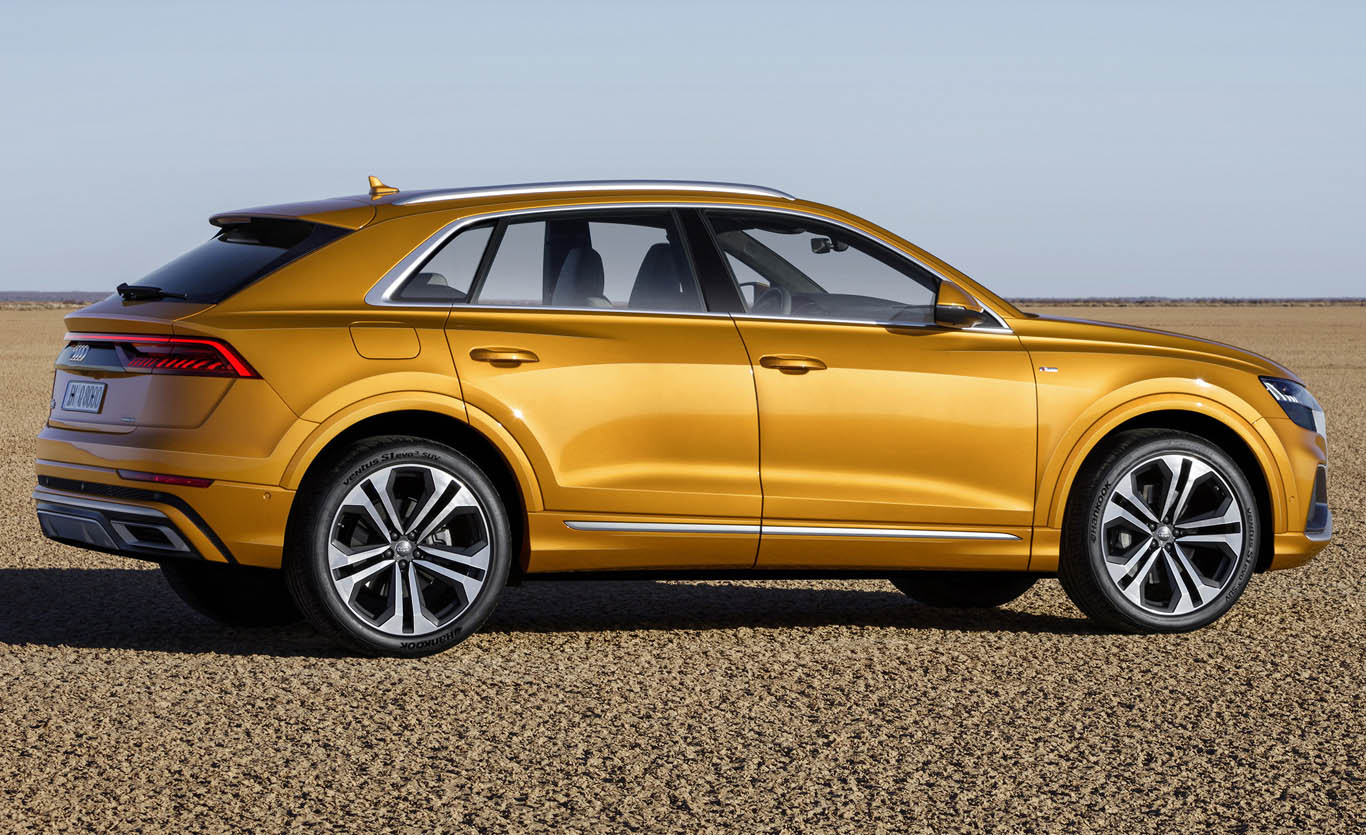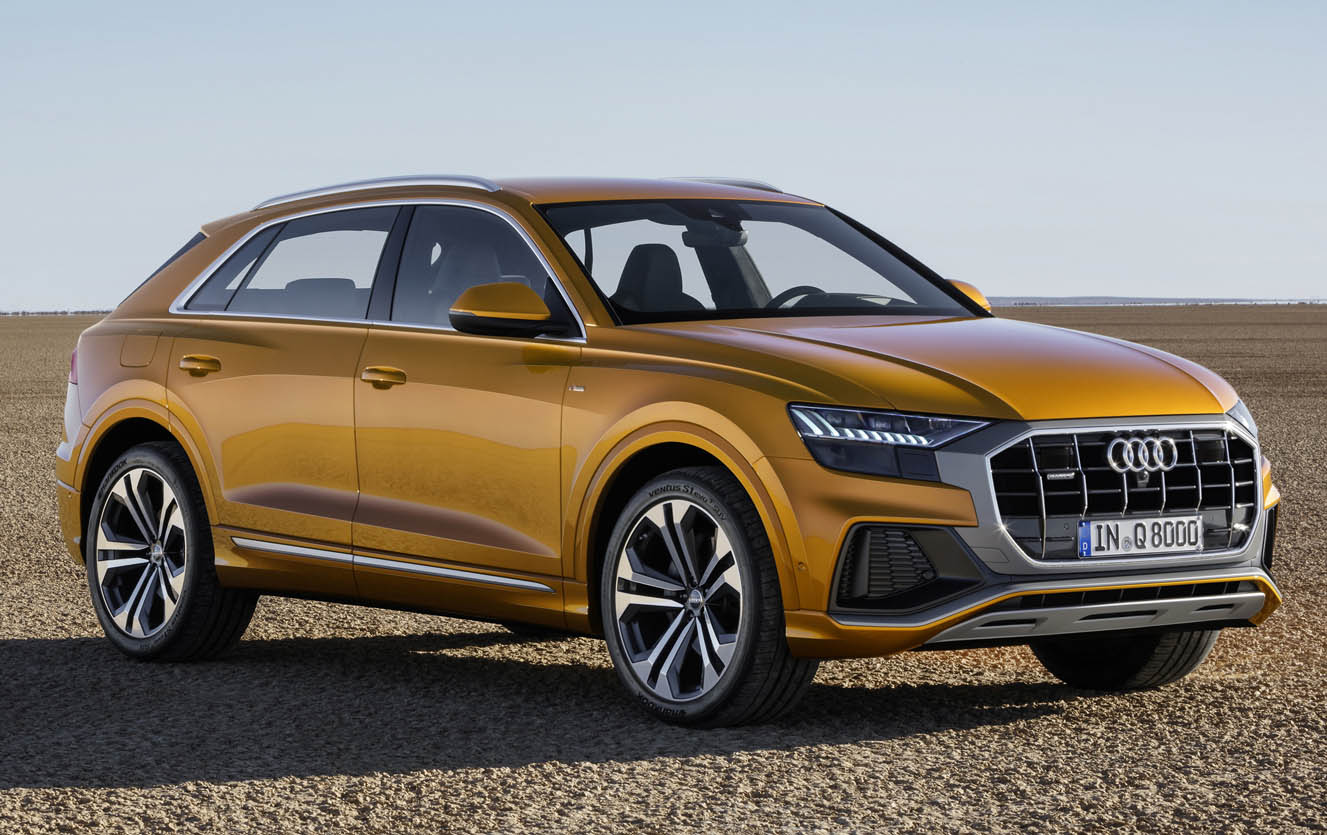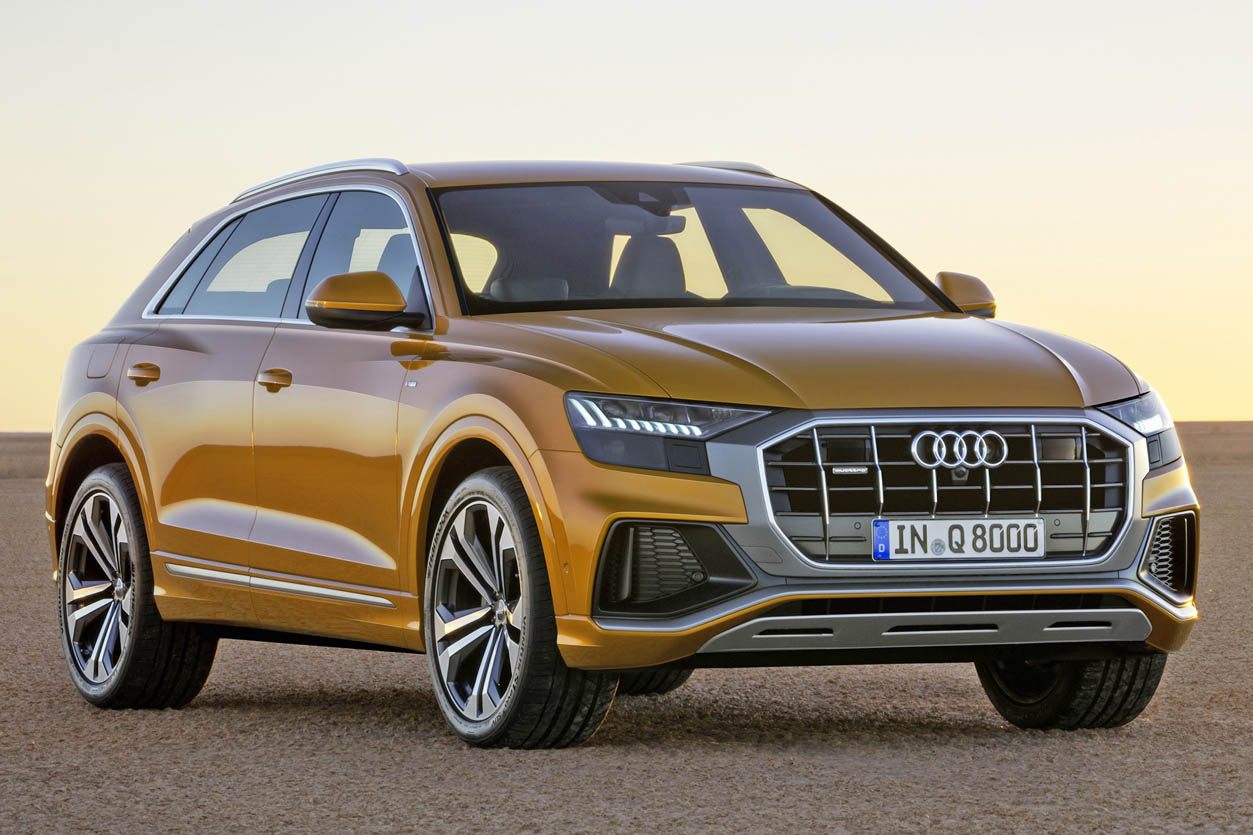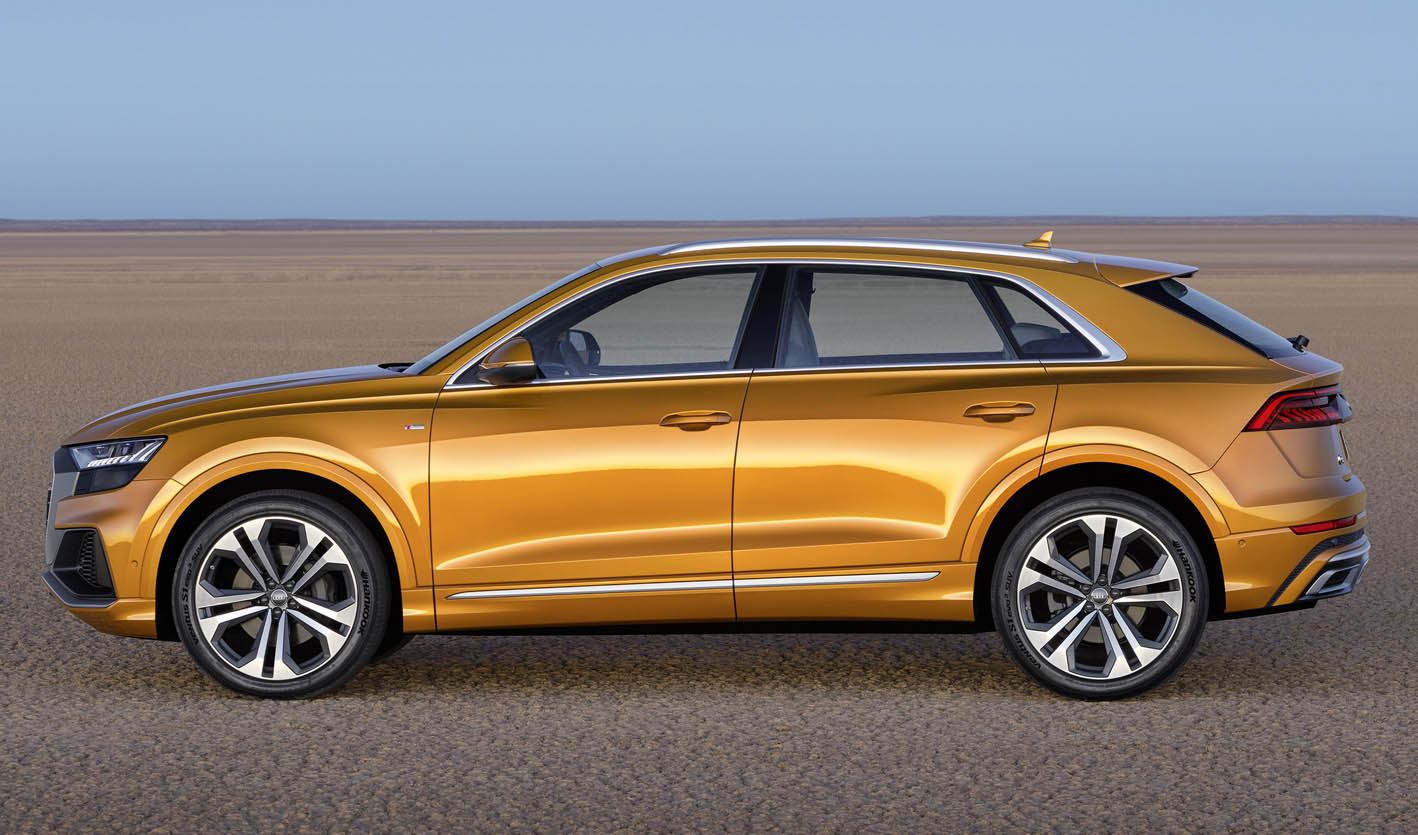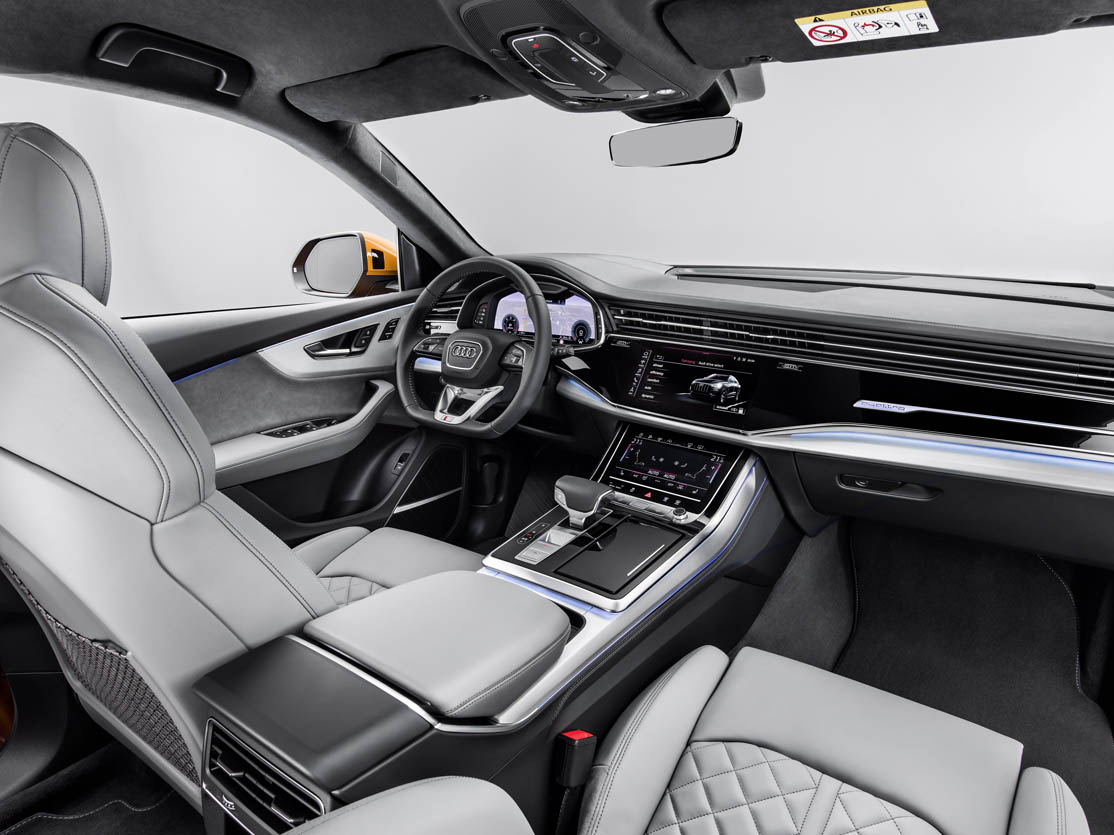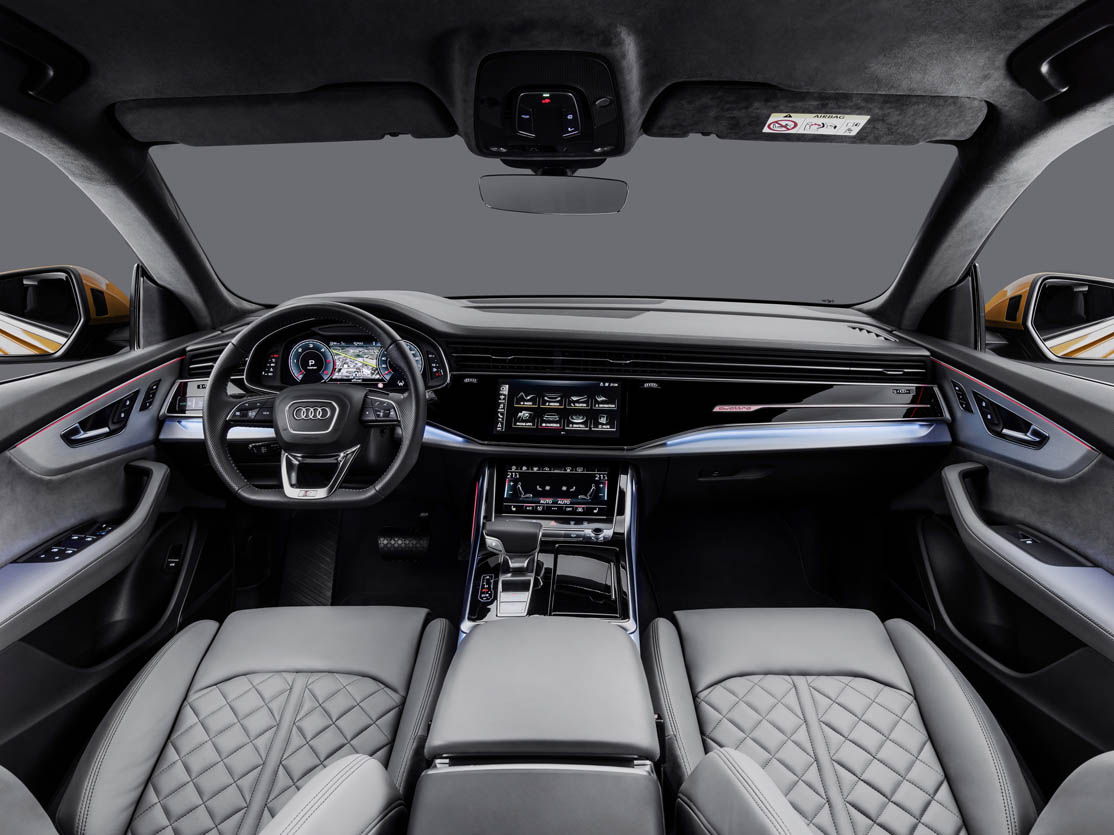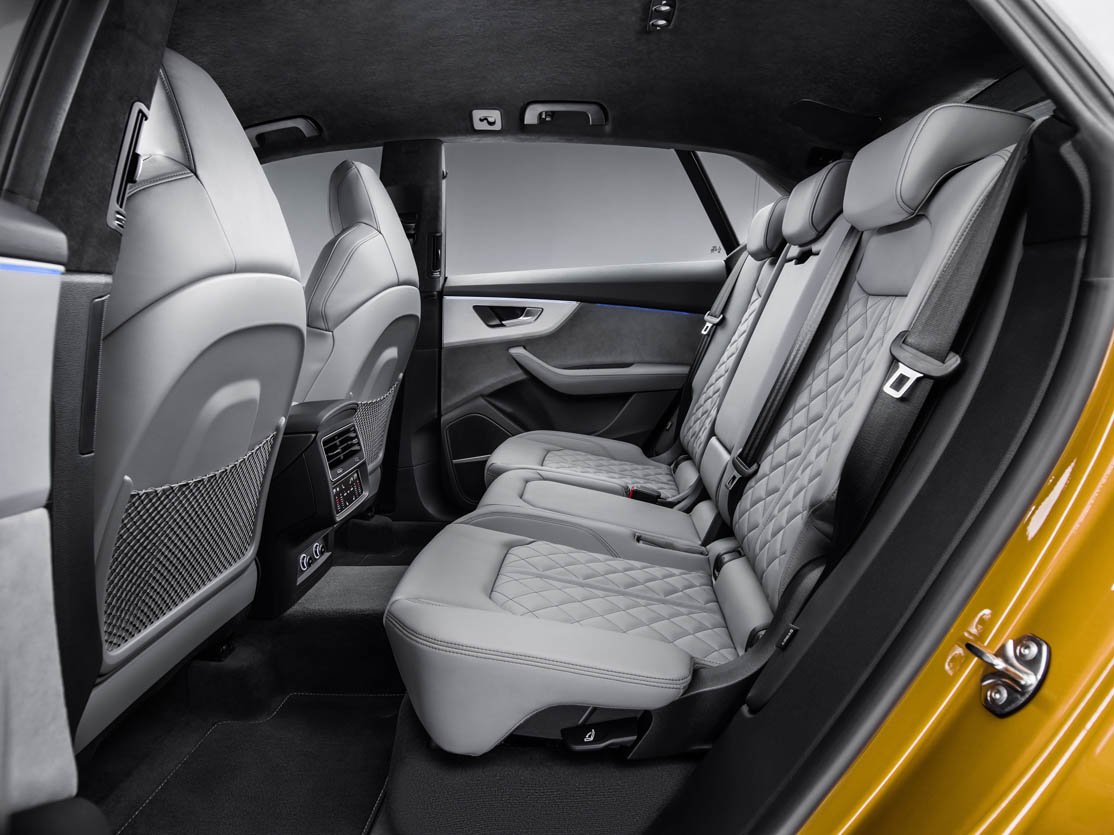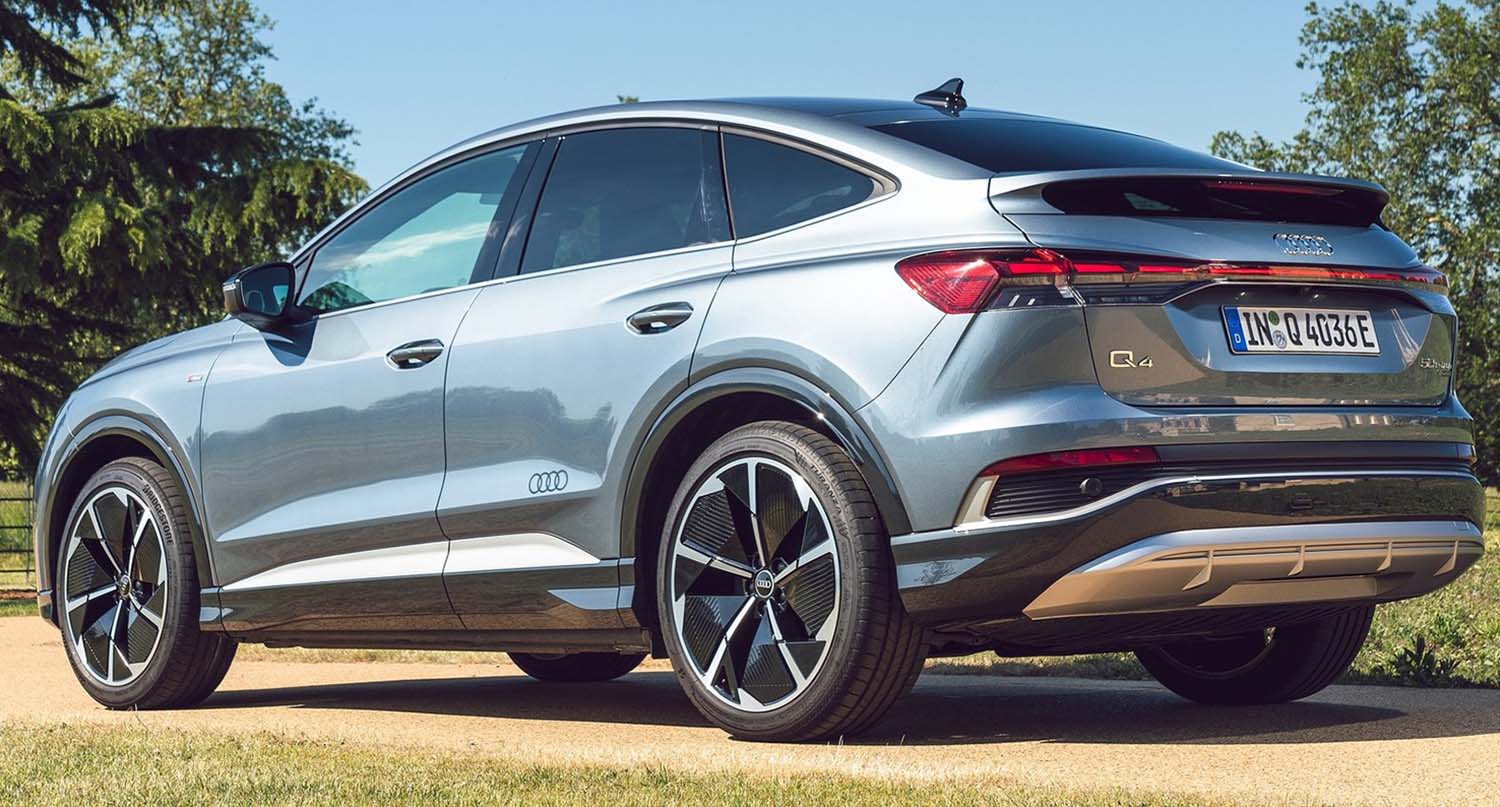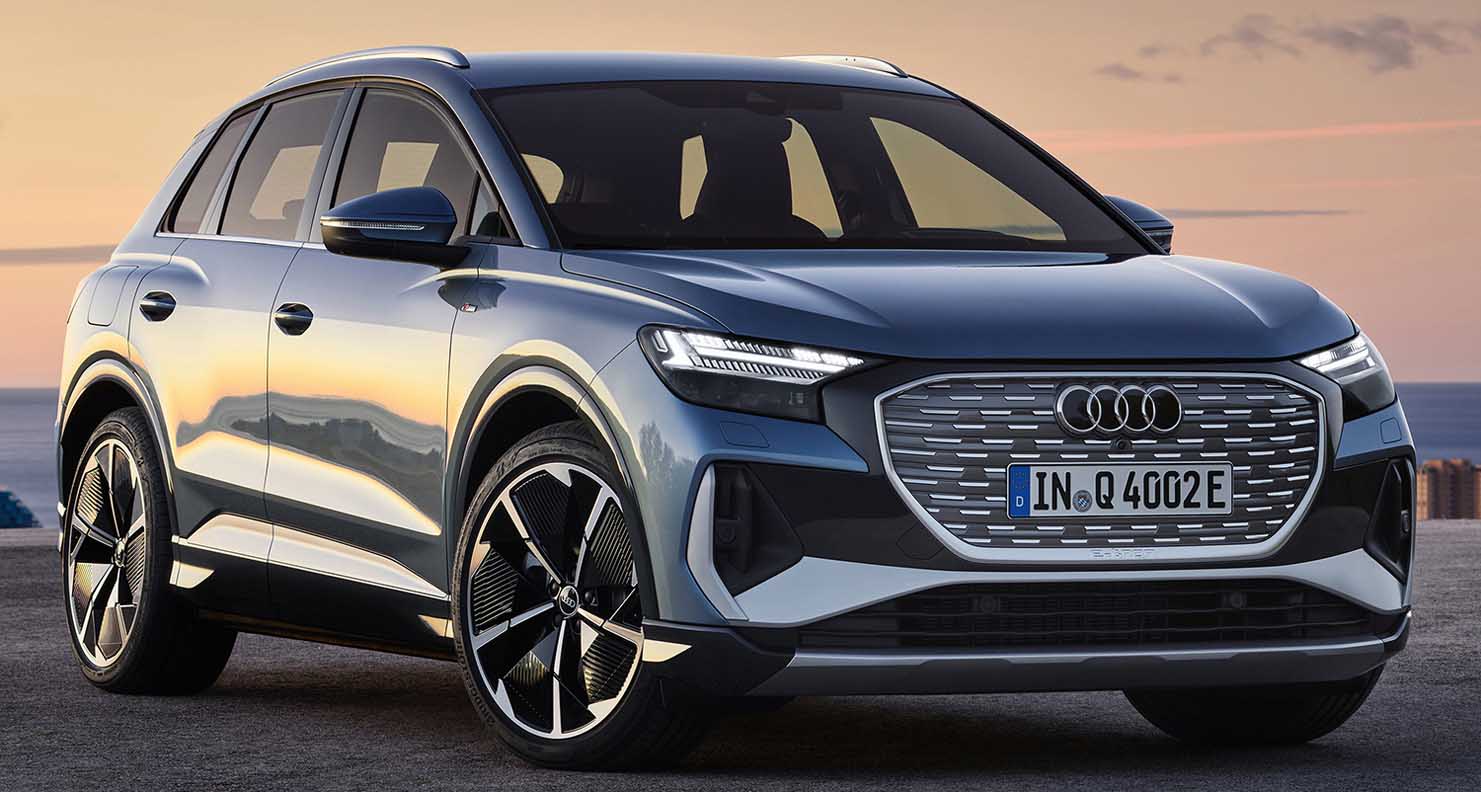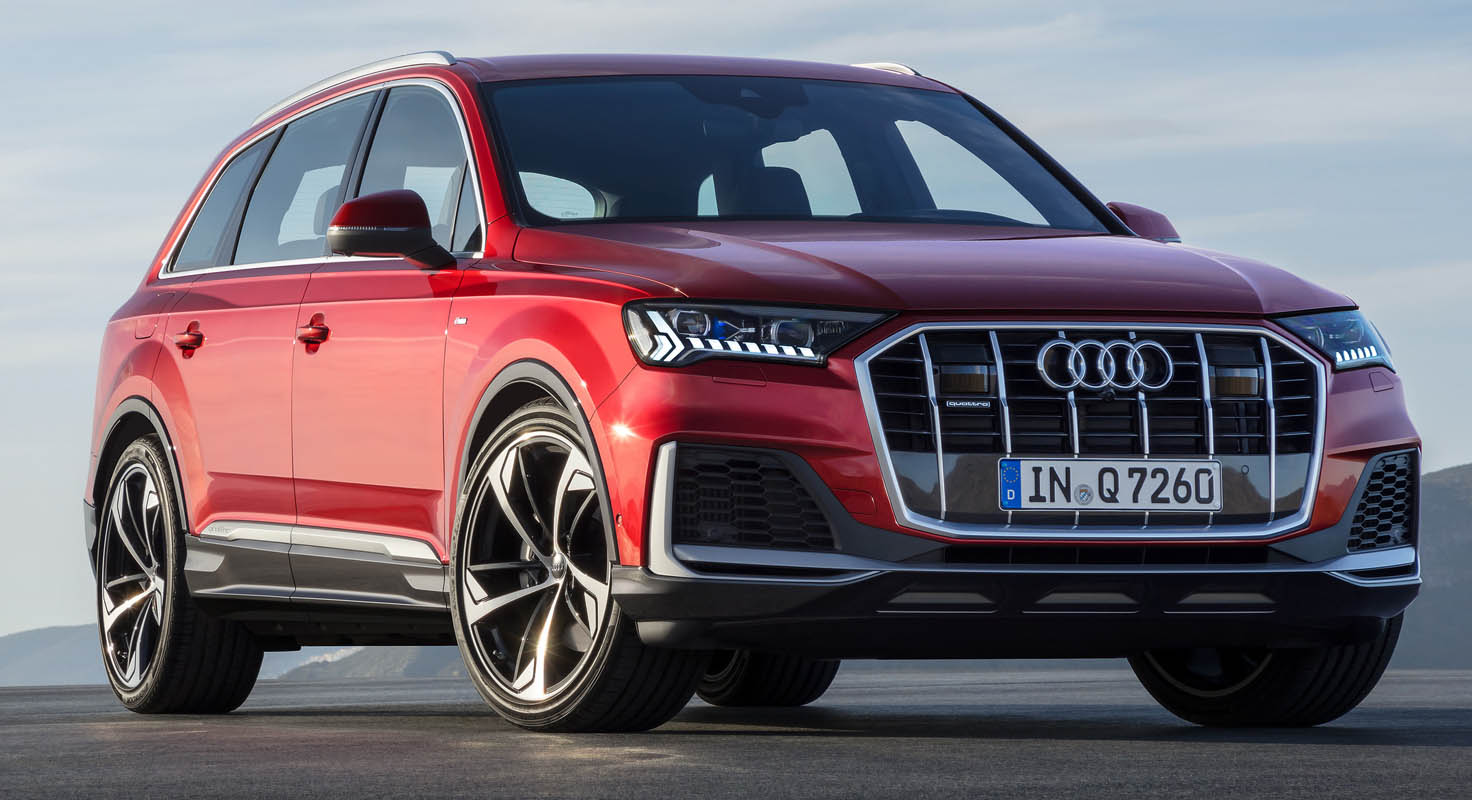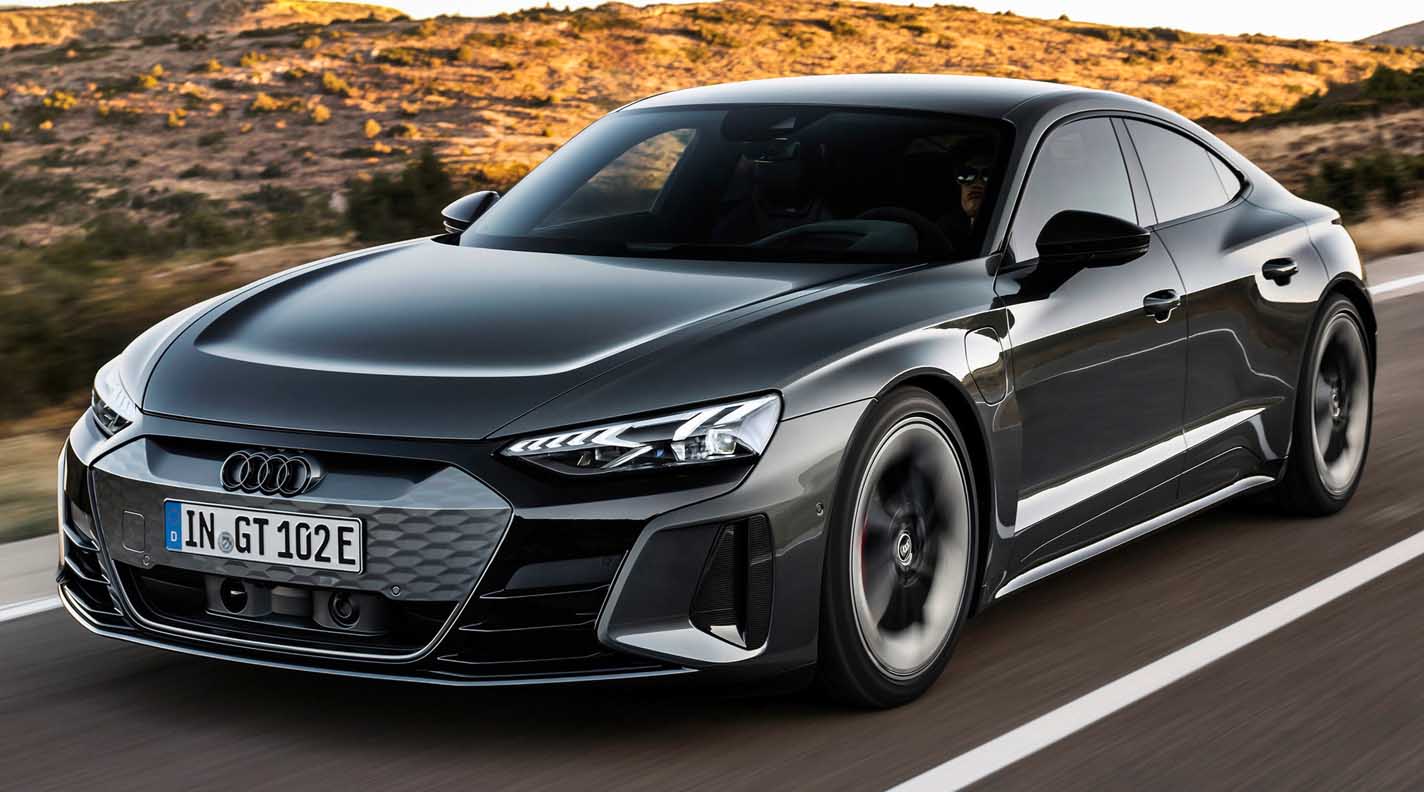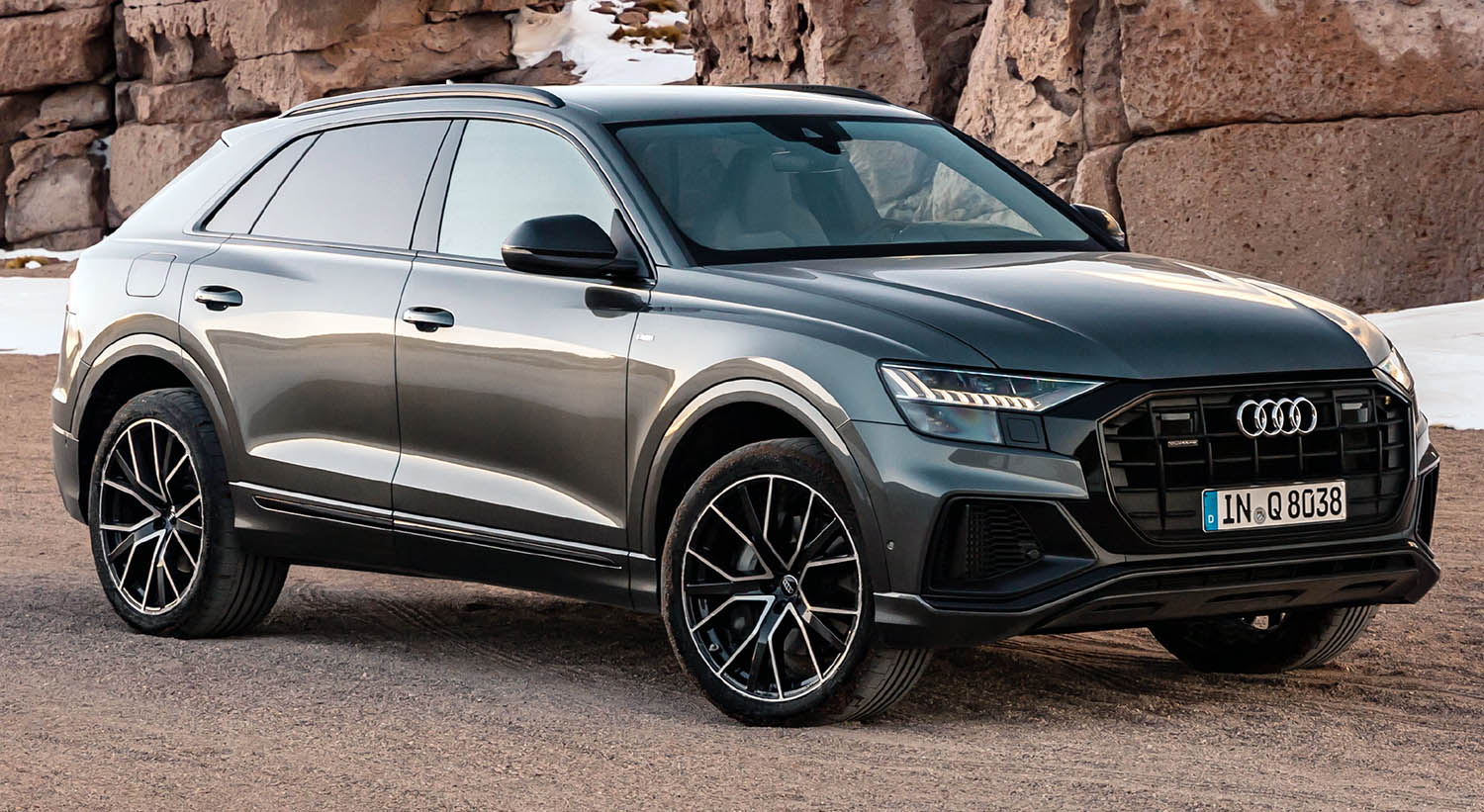
The Audi Q8 brings together the best of both worlds – the elegance of a four-door luxury coupé and the practical talents of a large SUV. The generously dimensioned interior with variable luggage compartment, state-of-the-art operating and suspension technologies as well as intelligent assistance systems make the Audi Q8 a composed companion for business and leisure. A powerful, yet efficient 3.0 TDI with mild hybrid system producing 210 kW (286 hp) provides the dynamics implied by the muscular design. With the permanent quattro all-wheel drive and a ground clearance of up to 254 millimeters (10.0 in), the SUV coupé can keep going when paved roads end.
Versatile, sporty, elegant: the dimensional and space concept
The Audi Q8 exudes sporty dynamics and upscale prestige like no other SUV from the brand with the four rings. 4.99 meters (16.4 ft) long, 2.00 meters (6.6 ft) wide and 1.71 meters (5.6 ft) tall, the SUV coupé is wider, shorter and lower than its Q7 sister model. With a wheelbase of nearly 3.00 meters (9.8 ft), it offers a spacious interior that beats that of its direct competitors in most relevant dimensions, including interior length and headroom. The three-seat system in the rear can be slid forward and backward as desired. With the seat backrests folded down, the luggage compartment under the power rear hatch holds up to 1,755 liters (62.0 cu ft).
New presence for the Q family: the exterior design
With the imposing Singleframe in octagonal design, the Audi Q8 is the new face of the Q family. The brawny radiator grille stands upright and, together with the spoiler that has been drawn toward the front and the large, highly contoured air inlets, emphasizes the self-confident look. The elegantly sloping roofline terminates in gently inclined D-pillars and rests against the quattro blisters above the wheel arches, which house up to 22-inch wheels. Numerous details echo the design of the Ur-quattro. Strong contours and athletically tight surfaces convey a feeling of power, sophistication and the special dynamics of permanent all-wheel drive. The spoiler, wheel arch trims, door trim strips and diffuser are in a contrasting color, to further emphasize the off-road look.
Standard LED headlights illuminate the road, with HD matrix LED technology available as an option. Here both the three-dimensional signature of the daytime running lights and the taillights have a digital character. A light strip connects the units at the rear. As in the Audi Ur-quattro, a black surface underlays this strip. Q8 owners can use the myAudi app on their smartphone to activate various lighting functions and experience them from the outside.
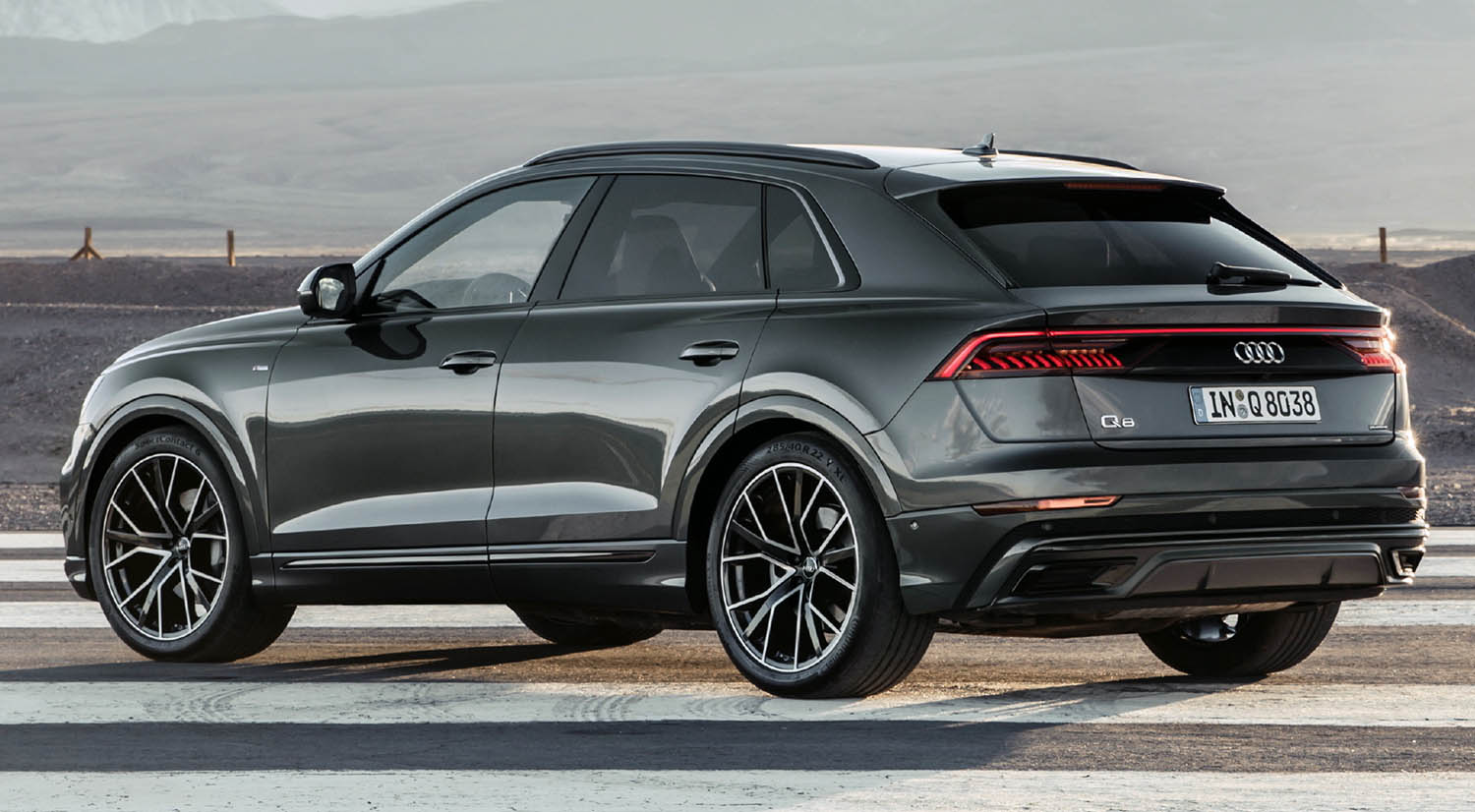
Sporty driving experience: suspension and drive
With as much as 254 millimeters (10.0 in) of ground clearance, short overhangs, quattro permanent all-wheel drive and hill descent control, the Audi Q8 can keep going when paved roads end. The suspension with damper control is standard.
Audi offers the adaptive air suspension with controlled damping as an option, with either comfort or sport setup. It adjusts the ride height depending on the driving situation and the driver’s preference by as much as 90 millimeters (3.5 in).
Besides the standard progressive steering, whose steering ratio becomes increasingly direct the further the steering wheel is turned, Audi also offers the option of all-wheel steering. It can turn the rear wheels as much as 5 degrees – counter to the direction of the turn at low speeds to increase agility and at higher speeds in the direction of the turn for better stability.
The SUV coupé will launch in Europe as the Q8 50 TDI (combined fuel consumption in l/100 km: 6.8 – 6.6 [34.6 – 35.6 US mpg]*; combined CO2 emissions in g/km: 179 – 172 [288.1 – 276.8 g/mi]*). The powerful 3.0 TDI produces 210 kW (286 hp) and develops 600 Nm (442.5 lb-ft) of torque. The Audi Q8 accelerates from 0 to 100 km/h (62.1 mph) in 6.3 seconds on its way to a top speed of 245 km/h (152.2 mph). A fast and smooth-shifting, eight-speed tiptronic transfers the power to the quattro drivetrain. Two further engine versions will follow at the beginning of next year.
All drive systems are particularly efficient thanks to the new mild hybrid technology (MHEV). The 48-volt main electrical system incorporates two important technology modules: a lithium-ion battery and a belt alternator starter. During braking, it can recover up to 12 kW of power and feed it back into the battery. The MHEV technology enables long coasting phases with the engine deactivated and a start-stop range that begins at 22 km/h (13.7 mph). In customer operation, it reduces consumption by up to 0.7 liters per 100 kilometers.
Clarity is the new premium: the interior
Easy-to-understand symbols stand for the digital precision from Audi and for the high level of integration of architecture and operation. The central element is the top MMI touch response display. With its black-panel look, it almost dissolves into a large, black surface when switched off. All elements refer logically to one another, from the flat air vent strip to the wide console on the center tunnel bearing the tiptronic selector lever. In the dark, the contour light traces the distinctive design lines of the interior and provides backlight for the three-dimensionally lasered quattro badge above the glove compartment – an example for the love of detail at Audi. Options including customized contour seats with massage function and ventilation, four-zone automatic air conditioning and the air quality package with fragrancing and ionizer further enhance the elegant ambiance.
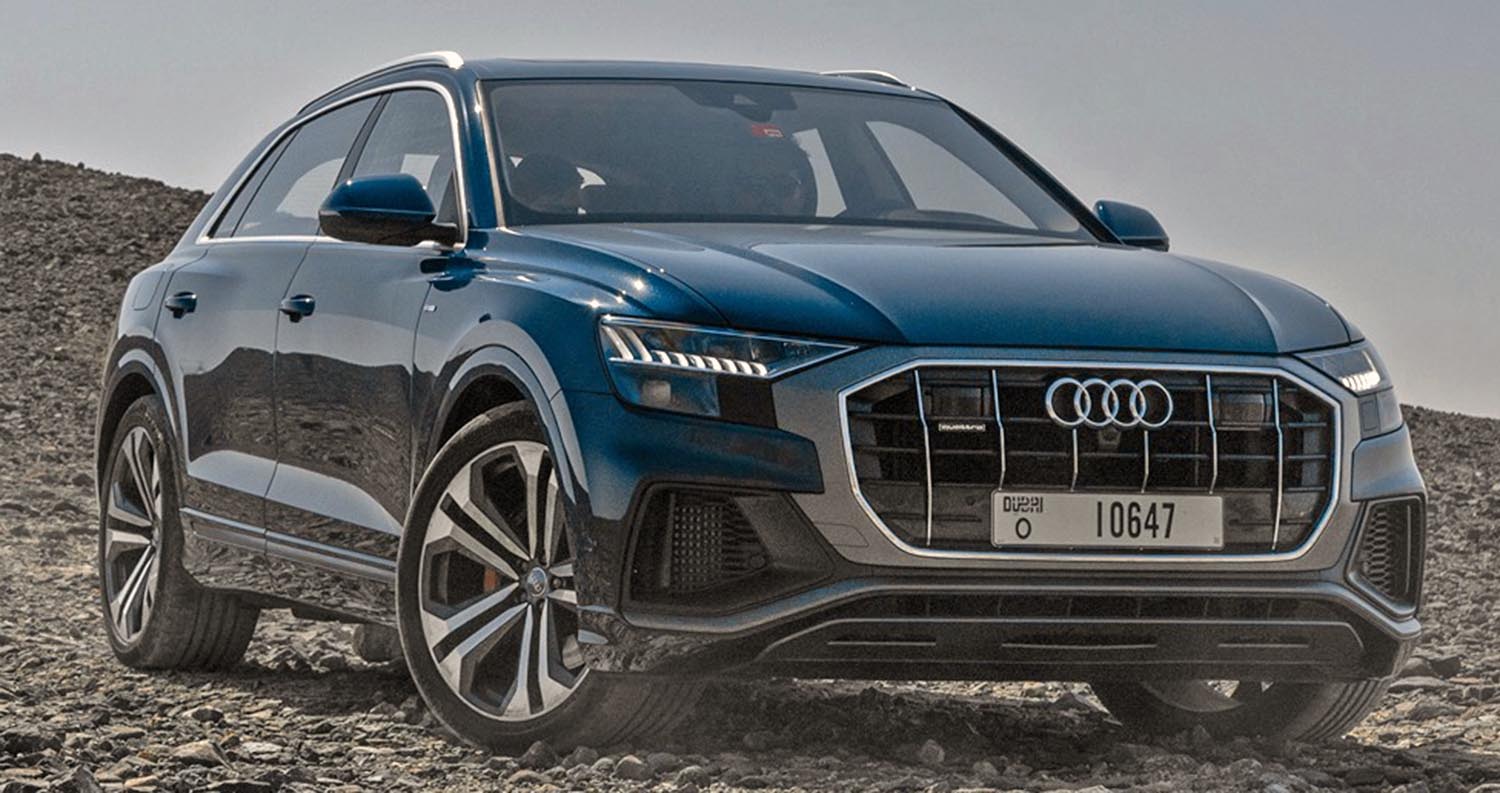
Sensitive and concise: controls and displays
With the MMI touch response operating concept of the new Audi Q8, nearly every function can be accessed via two large displays. The upper 10.1-inch display is used for controlling the infotainment and the navigation system. The driver uses the 8.6-inch display below that for heating and air conditioning, convenience functions and text input, the latter with his or her wrist resting comfortably and ergonomically on the selector lever.
Operation is swift and simple: A tactile and acoustic click confirms when a finger activates a function. In addition to all this, the natural language voice control turns the Audi Q8 into an intelligent dialog partner. Drivers can word their commands freely. The voice control can, for example, understand the sentence “I am hungry” and in response suggests restaurants close by.
The instruments are shown in the fully digital Audi virtual cockpit. Its high-resolution 12.3-inch display can be switched between two views via the multifunction steering wheel. The optional plus version includes a third, particularly sporty view. The head-up display also projects important information onto the windshield, including detailed lane guidance for navigation.
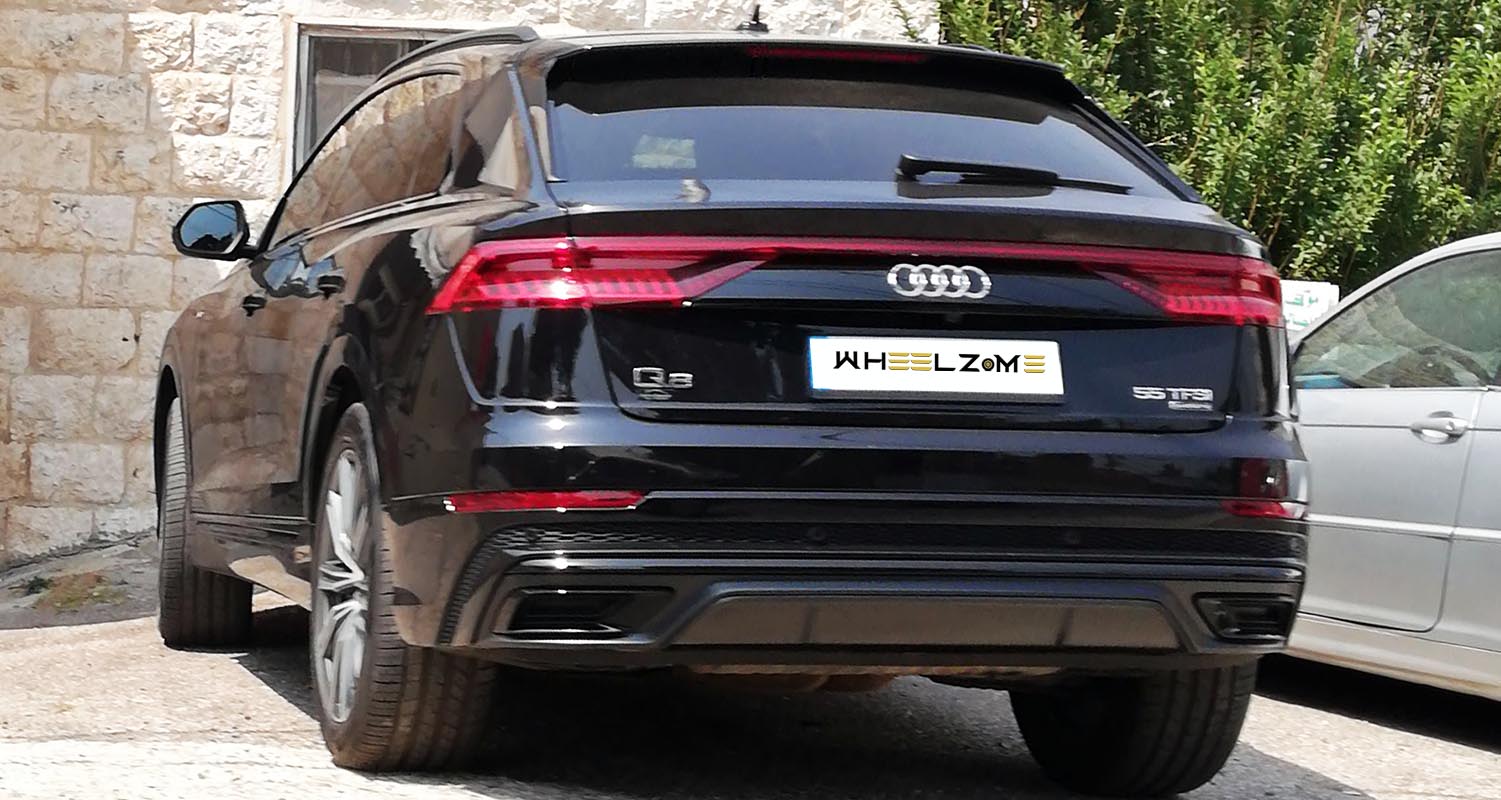
Clever networking: Audi connect and driver assistance systems
On the German market, the Audi Q8 comes standard with the top-of-the-line infotainment system, MMI navigation plus. It includes the Audi connect data transfer module with the LTE Advanced standard and a Wi-Fi hotspot. The navigation system recognizes the driver’s preferences based on previous journeys and therefore can make intelligent suggestions. The online services from Audi connect add predictive features to the route planning process. This lets the two Car-to-X services for traffic sign information and hazard information benefit from the swarm intelligence of the Audi fleet. The optional Audi connect key lets the driver lock/unlock the vehicle, and start the engine using an Android smartphone. Individual user profiles allow as many as 400 preferred settings to be stored for multiple drivers. With the myAudi app, drivers can also transfer special destinations to the navigation system, stream music or transfer the smartphone calendar to the MMI.
The Audi Q8 is top-notch with respect to sound and connection quality thanks to the Audi phone box and voice-over LTE. The same applies to the Bang & Olufsen Advanced Sound System. It delivers fascinating 3D sound with height information to all five seats. The music unfolds exactly how it was recorded in the concert hall.
Whether parking, in the city or on long journeys – the Audi Q8 supports its driver in many situations. Among the systems contributing here are the adaptive cruise assist, efficiency assist, crossing assist, lane change warning, curb warning and 360 degree cameras. One highlight is the remote garage pilot, which will follow in early 2019. Under the supervision of the driver, it guides the SUV into a garage and back out again autonomously. The driver gets out of the car beforehand and activates the process using the myAudi app on their smartphone. The (remote) parking pilot offers a similar level of convenience. Behind all of these features is the central driver assistance controller. It continuously computes a differentiated model of the surroundings and uses this to manage the assistance systems. The required data are obtained – depending on the selected options – from up to five radar sensors, six cameras, twelve ultrasound sensors and the laser scanner.
Dimensional and space concept
4,986 millimeters (16.4 ft) long, 1,995 millimeters (6.5 ft) wide and 1,705 (5.6 ft) millimeters high – these dimensions describe the new Audi Q8, which exudes sportiness and prestige like no other SUV from the brand with the four rings. With its coupé-style roof line and the frameless doors, it is 38 millimeters (1.5 in) lower than its Q7 sister model. It is 66 millimeters (2.6 in) shorter, but has become 27 millimeters (1.1 in) wider. The distinctive front end, the short rear overhang, the high ground clearance of up to 254 millimeters (10.0 in) with the adaptive air suspension and the hefty 22-inch wheels with a diameter of 795 millimeters (31.3 in) paint a picture of powerful dynamics.
With a wheelbase of 2,995 millimeters (9.8 ft), the Audi Q8 offers ample space for five people. It is more spacious than the competition with respect to interior length, front and rear elbow and headroom, and rear legroom. The standard three-seat system in the rear can be slid longitudinally by ten centimeters (3.9 in). Large storage compartments and pockets, particularly in the doors, prepare the Audi Q8 for long trips. All together they have a capacity of more than 14 liters (0.5 cu ft).
The luggage compartment of the SUV coupe holds 605 liters (21.4 cu ft) as standard, which increases to 1,755 liters (62.0 cu ft) with the rear backrests folded down. Two golf bags can easily fit in crosswise. A power rear hatch is standard; foot-activated gesture control is available as an option. The electric luggage compartment cover is another convenience option. Guided on rails, it automatically retracts when the tailgate is opened and is extended again upon closing.
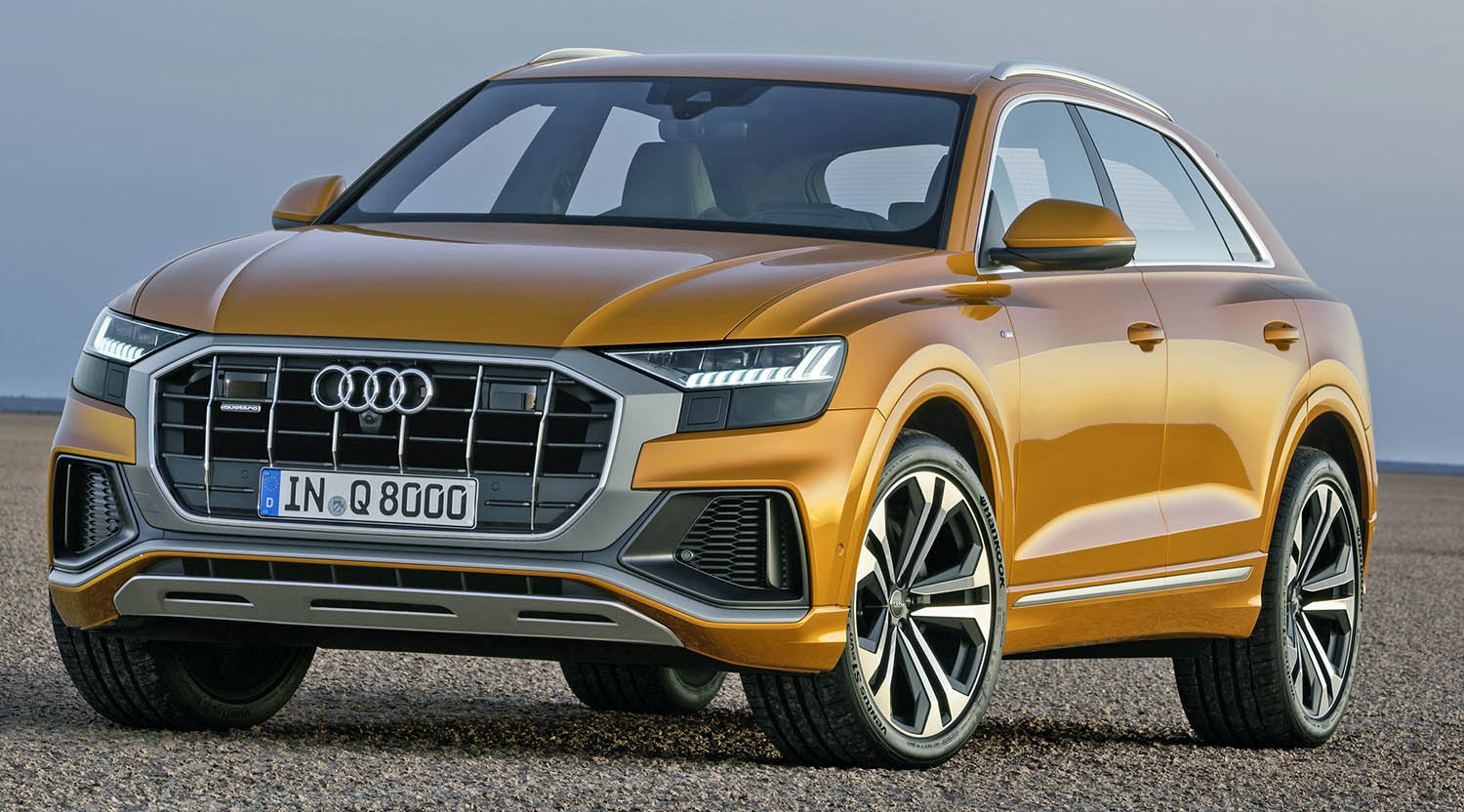
Luxury coupé meets SUV
The Audi Q8 is an impressive representative of the progressive design language that Audi first brought onto the road with the new A8. Strong contours and athletically tight surfaces convey a feeling of power, sophistication and the special dynamics of permanent all-wheel drive. The Q8 interprets this in its very own way, as the fusion of an elegant four-door luxury coupé with a large SUV, and with echoes of an Audi icon – the Ur-quattro.
Style-defining: the octagonal Singleframe
The imposing Singleframe in octagonal design is the calling card of the Q8 and also the new face of the Audi Q family. Six vertical chrome struts give the radiator grille a dominant appearance. The crossbars are recessed and finished in dark gray. A wide mask optionally finished in a contrasting color connects the Singleframe to the distinctive headlights – a reminiscence of the Ur-quattro. The spoiler, which is pulled towards the front, and the large, strongly contoured air intakes additionally highlight the self-assured look.
Tautly athletic: the side view
Thanks to the frameless doors, the coupé-like roof line stretches low across the vehicle body visually, ending in a long roof spoiler. The roofline arches slightly towards the brawny, flat-sloping D-pillars, which are supported by wide, muscular contours – the quattro blisters, reminiscent of the Audi Ur-quattro. Depending on the how the light falls, they create intensive light and shadow effects on the flank, also in interaction with the arched shoulder line aiming at the wheel arches and with the hollow groove in the lower area of the doors.
As with the Ur-quattro: the black trim strip
Sporty compact proportions, paired with the low roof and a flat window form the rear end. The luggage compartment hatch of the Audi Q8 ends in a spoiler lip that joins the rear quattro blisters. A narrow, high-gloss black element with an integrated light strip extends between the rear lights. This is a feature of top Audi models, accentuating the width of the Q8. It creates an independent light signature day or night, just like on the Ur-quattro back in the day. The striking diffuser with its four vertical guide elements takes up the look of the Singleframe. Large exhaust tailpipe trims are integrated into its edges.
Dragon orange and galaxy blue: paint finish and attachments
The Audi Q8 is available in a choice of twelve colors: two solid paint finishes and ten metallic or pearl effect shades. The new color dragon orange, which is exclusive to the Q8, dramatically underscores the sporty design. The attachments on the SUV coupé – bumpers, wheel arch trims, sills and diffuser – come standard in anthracite, grained. They are optionally available in the body color or the contrasting color scandium gray, a high-gloss anthracite shade. In the S line exterior package, the mask of the Singleframe, the decorative clasps in the lower section of the front and rear, the underbody protection and the sill inserts are finished in platinum gray, matt. This emphasizes both the dynamics of the Audi Q8 and the offroad look. With carefully placed accents, including at the window and the Singleframe, the black styling packaging fits perfectly with the prestige of the brand’s newest Q model.
Digital character: the daylight running light signature
For the headlights, Q8 customers can choose between two versions, both in LED technology. From a distance the two-piece luminaires look very flat. Integrated into their upper section are the daytime running lights and the low beam, among other functions. The high beam is positioned underneath, darkened and offset to the back. In the optional HD matrix LED headlights, each high beam comprises 24 individual LEDs. They illuminate the road dynamically and precisely while excluding other road users from the cone of light. They also serve as the cornering light.
With the top-of-the-line headlights, the daytime running light signature has a digital character and for the first time is strongly three-dimensional. It consists of seven short segments and two longer ones at the edge of the headlight. The latter shift the visual focus to the outside, highlighting the width of the Audi Q8. The taillight uses a similarly three-dimensional design with its twelve segments – connected by the distinctive light strip which conveys depth. When braking, the brake light fills the surfaces between taillight segments.
In combination with the HD matrix LED technology, headlights and taillights not only feature dynamic turn signals, they are also expressively showcased whenever the car is locked or unlocked. With the leaving home function, for example, a dimmed point of light first swipes from the inside out when the SUV is unlocked. It then moves back at full brightness to fully illuminate the segments. With the coming home function, this sequence plays out in reverse when leaving the Audi Q8. The harmonious interplay between the headlights and taillights gives the SUV a dynamic character. In the future, Q8 owners will be able to use the myAudi app on their smartphone to activate various functions of the HD matrix LED headlights such as the cornering light and experience them from the outside – a unique feature in the competitive field.
Powerful, cultivated, efficient: the 3.0 TDI
The Audi Q8 will launch in the European markets as the Q8 50 TDI with the 3.0 TDI. The V6 diesel produces 210 kW (286 hp) and delivers 600 Nm (442.5 lb-ft) of torque. It accelerates the large SUV from 0 to 100 km/h (62.1 mph) in 6.3 seconds on its way to a top speed of 245 km/h (152.2 mph). Two more engine variants will follow in early 2019.
The 3.0 TDI in the Q8 50 TDI offers sophisticated solutions for many technologies. Thanks in part to its crankcase of lightweight vermicular graphite cast iron, it weighs just 190 kilograms (418.9 lb). The camshafts are hollow. The crankcase and the cylinder heads have separate coolant circuits so the ideal temperature level can be set for any driving situation. The heads feature two-piece water jackets. Cast-in channels cool the pistons with oil. Their rings and the wrist pins are designed for minimum friction; the oil pump is fully variable. The turbochargers generate up to 2.0 bar of relative charging pressure.
Switchable hydraulic bearings connect the 3.0 TDI to the subframe of the front axle. At idle, they eliminate vibrations with soft characteristic curves; while driving they use higher damping to suppress engine vibrations. The powerful TDI is highly cultivated and very efficient. In the NEDC, the base version of the Audi Q8 50 TDI consumes 6.6 liters of fuel per 100 kilometers (35.6 US mpg), corresponding to 172 grams of CO2 per kilometer (276.8 g/mi). Standard capacity of its SCR tank is 24 liters (6.3 US gal).
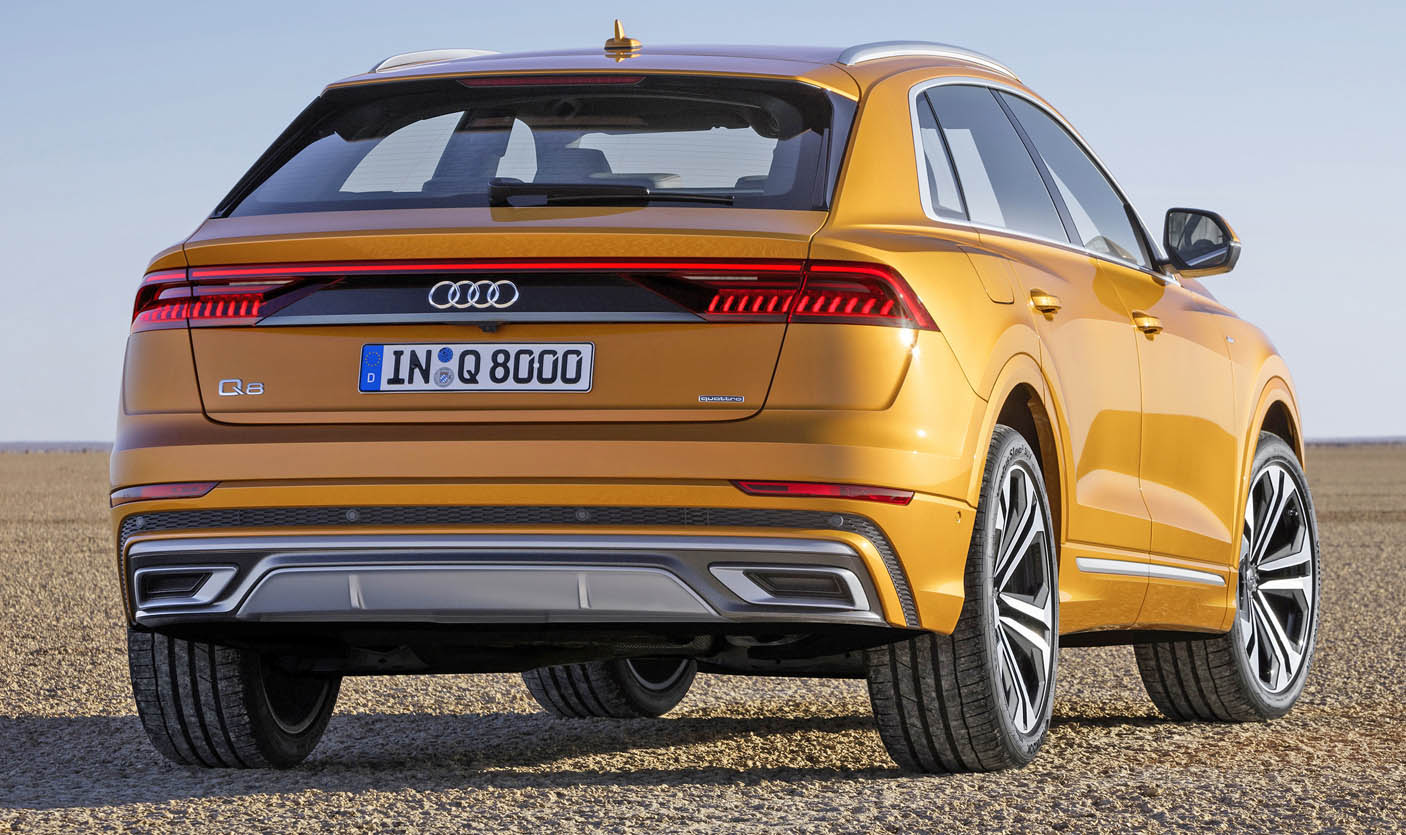
Lithium-ion battery and belt alternator starter: the mild hybrid technology
A key factor for the efficiency is the mild hybrid technology from Audi. In customer operation, it can save as much as 0.7 liters per 100 kilometers. In the Audi Q8, a 48-volt main electrical system incorporates two important technology modules: a lithium-ion battery located beneath the luggage compartment floor and a 48-volt belt alternator starter (BAS) connected to the crankshaft. During braking, it can recover up to 12 kW of power and feed it back into the battery.
At speeds between 55 and 160 km/h (34.2 and 99.4 mph), the SUV coupé can coast for up to 40 seconds with the engine deactivated when the driver lets off the accelerator. The BAS then restarts the engine quickly and very smoothly. The start-stop range begins at 22 km/h (13.7 mph).
Extremely smooth and fast: the transmission
The 3.0 TDI is paired standard with an eight-speed tiptronic that shifts fast and smoothly. A torsional vibration damper, which acts based on engine speed, largely compensates vibrations due to the engine’s work cycles to allow efficient driving even in the low-rev range from 1,000 rpm. When coasting and rolling out, a clutch in the central transmission opens and interrupts the power connection. With its electric oil pump, the tiptronic can engage the gear required for restarting while coasting with the engine switched off. Special ventilation allows off-road use.
Audi is quattro, and quattro is Audi. With the Q8, the brand’s top SUV, the permanent all-wheel drive is always on board. Constructed as a planetary gear, the purely mechanical center differential normally transfers the forces to the front axle and rear axle at a ratio of 40:60. If one wheel slips, most of the drive torque automatically goes to the axle with the better traction. Up to 70 percent can flow to the front wheels and up to 85 percent to the back wheels. During sporty driving, wheel-selective torque control – an intelligent software function of the ESC Electronic Stabilization Control – minimally brakes the wheels on the inside of a curve. The car turns into the curve ever so slightly. Turn-in behavior remains neutral longer, and handling becomes more precise, agile and stable.
Sporty and robust: the suspension
Responsive on narrow country roads, composed on the highway and robust off-road: the suspension of the Audi Q8 also combines the best characteristics from various worlds. Five-link suspensions are used at the front and rear so that longitudinal and lateral forces can be handled separately. The linkages and the subframes are made largely of aluminum. The SUV coupé has a track of 1,679 millimeters (5.51 ft) up front and 1,691 millimeters (5.55 ft) at the rear.
The standard progressive steering in the Audi Q8 features a sporty and rather low ratio of 14.6:1 in the center position and becomes even more direct with increasing steering angle. The steering system with its electromechanical drive provides differentiated road feedback. It responds spontaneously and is highly precise.
Audi also offers optional all-wheel steering. With this system, a high-torque electric spindle drive and two track rods turn the rear wheels. At low speeds, they turn up to 5 degrees opposite the direction of the front wheels. They thus reduce the SUV’s turning circle by a good meter (3.3 ft) and make it even more agile. At high speeds, they turn up to 1.5 degrees in the same direction as the front wheels to provide greater stability during fast lane changes.
The Q8 rolls off the assembly line on 19-inch wheels with particularly good aerodynamic properties and 265/55-series tires. 20-, 21- and 22-inch tires are optionally available, the latter with 285/40 tires. All wheels are 20 millimeters (0.8 in) larger in diameter than those of the Q7. The 21- and 22-inch wheels feature torus absorbers – layers of foam between the running surface and the carcass – to dampen undesired frequencies and noise radiation. Mounted on the front axle of the Audi Q8 are six-piston, fixed-caliper brakes. The discs have central pots made of aluminum; the internally vented friction rings are made of cast iron. They measure a large 375 millimeters (14.8 in) in diameter up front and 350 millimeters (13.8 in) in the back.
Versatile: the adaptive air suspension
Customers can choose between three variants for the suspension setup. The suspension with damper control is standard. The adaptive air suspension with controlled damping is an optional feature, with either comfort or sport setup. The Audi Q8 then sits a good 15 millimeters (0.6 in) lower than with a steel spring suspension, which has 220 millimeters (8.7 in) of ground clearance. The air suspension can be set to four modes via the Audi drive select dynamic handling system, varying the ride height of the body by up to 90 millimeters (3.5 in) depending on the driver’s wishes and the driving situation. At speeds up to 30 km/h (18.6 mph), the driver can increase ground clearance by up to 50 millimeters (2.0 in). As the speed increases the suspension automatically lowers the body in stages. This leads to a reduction in air resistance and increased driving dynamics.
At speeds of 160 km/h (99.4 mph) and above, or if the driver selects the dynamic mode in Audi drive select the vehicle is lowered by 40 millimeters (1.6 in) compared to the normal level. When the car is parked, the system can also lower the loading level by 65 millimeters (2.6 in) relative to the normal level.
Tightly networked: Audi drive select and the electronic chassis platform
With Audi drive select, drivers can vary the characteristics of their SUV between seven profiles – comfort, auto, dynamic, individual, efficiency, allroad and offroad, the latter only in combination with the air suspension. The dynamic handling system influences engine and transmission management, steering boost, the function of the automatic air conditioning and the optional all-wheel steering among other things.
Management of all adjustable suspension systems is integrated into the control unit for the electronic chassis platform (ECP). The systems are tightly networked and work in a highly coordinated manner with maximum precision. The dampers are actuated in millisecond cycles, for example. As the central suspension controller, the ECP collects all key data about the movement of the car and about the systems involved. The integral dynamic handling controller then uses these data to compute the optimal function of these components.
Off the beaten track: hill descent control
Off-road, the Audi Q8 benefits from quattro drive, the short overhangs and the high ground clearance – a maximum of 25.4 centimeters (10.0 in) with the adaptive air suspension. With the standard suspension it is 22 centimeters (8.7 in). If the driver chooses offroad mode in Audi drive select, the electronic stabilization control automatically switches to stability, traction and braking control modes that are optimized for off-road driving. It also activates the standard hill descent control. On steep slopes over six percent, this function provides support with automatic braking input. The system maintains a constant speed up to a maximum of 30 km/h (18.6 mph), which the driver sets by accelerating or braking. This allows the driver to concentrate fully on the terrain. The electronic chassis platform captures the tilt angle of the car and displays this information for the driver on the MMI. The ESC also has a sport mode that enables even more agile handing by adjusting the influence on engine torque braking input. The driver can also deactivate the ESC in part by pressing a button.
Intelligent mix: the multi-material ASF
The body of the Audi Q8 is based on the Audi Space Frame (ASF) in multi-material construction. It presents an intelligent mix of materials, including many parts made of aluminum and hot-shaped steel. The Audi Q8 50 TDI has an unladen weight of 2,145 kilograms (4,728.9 lb) – including the elaborate MHEV technology with lithium-ion battery.
Hot-shaped steel components comprise 14.4 percent of the body-in-white’s weight and form the ultra-high-strength backbone of the occupant cell. They are used in the lower section of the bulkhead, in the side sills, the rear longitudinal members, the B-pillars and the front zone of the roof frame. In some areas, Audi uses blanks with tailored, variable wall thicknesses between barely one and a good two millimeters (0.04 and 0.1 in). These tailored blanks combine low weight with high strength.
Aluminum castings, such as the strut mounts in the engine compartment and the connecting points between the sills and longitudinal members, comprise 15.0 percent. 2.4 percent is due to the aluminum profiles that make up the front sections of the longitudinal members. The side panel as well as large areas of the floor, the rear wheel housings and the roof are mode of aluminum sheet, as are the frameless doors, the front fenders and the rear hatch. They comprise 23.7 percent.
Composed: rigidity and aeroacoustics
The body of the Audi Q8 stands out for its high rigidity, due in part to a new concept for the torsion rings. Integrated into both the front and rear ends, they are the foundation for the precise handling of the SUV coupé, be it fast and agile driving on paved roads or when driving off-road. Their optimized structure in the rear end made it possible to eliminate the C-pillar without sacrificing comfort or safety. In a head-on collision, the three stress planes in the front end absorb the forces. The reinforcements of the longitudinal members have variable wall thicknesses, which leads to controlled deformation.
The interior of the SUV coupé is very quiet thanks to elaborate sound insulation and sophisticated aeroacoustics. A double-layer windshield is standard. Audi also offers acoustic glazing for the side windows as an option. The frontal area of 2.84 m2 (30.6 sq ft) and a Cd value of 0.34 ensure relatively low drag. This puts the Audi Q8 on a level with its competitors, with drag similar to that of the Audi Q7.
Simplicity rather than complexity: the interior design
The interior of the Audi Q8 is a luxury lounge. The central element is the top MMI touch response display. With its black-panel look, it almost dissolves into a large, black surface when switched off. When active, its simple, easy-to-understand graphics symbolize the digital precision of Audi and the high level of integration between architecture and operating concept: simplicity replaces complexity. All fundamental lines originate from the large display, for example the continuous air vent strip with integrated chrome fins and an elegant aluminum-look strip.
The slender dashboard and the strong horizontal focus of the lines highlight the impression
of width conveyed by the interior of the Audi Q8. This is also reinforced by the large, optional panoramic glass sunroof. The styling in the interior is deliberately clean and simple. All elements have a logical connection and harmonize with one another: from the “wrap around” – the large arch running from the front doors across the instrument panel – to the operating unit for the light, which is optionally available in black-panel look and with a touch surface. All this combined gives the interior a feeling of calm and a subtle sense of well-being.
Another important design element in the interior of the Audi Q8 is the wide, symmetrical console of the center tunnel. Framed by a striking chrome strip, it clearly expresses the character of the SUV. Besides the tiptronic selector lever and the button for the electronic parking brake, the console is also home to the lower MMI touch response display. Customers can choose from three multifunction steering wheel variants, two of which have shift paddles for the eight-speed tiptronic.
Audi offers two lighting packages in the new Q8: the standard ambient lighting package and the contour/ambient lighting package. The top version, in particular, attractively showcases the interior. In the indirect ambient lighting radiated from a surface source, the instrument panel, door linings and center tunnel seem to float, while the precise contour lighting traces the distinctive design lines. Even the three-dimensionally lasered quattro badge above the glove compartment – an example for the love of detail at Audi – is backlit here. Q8 customers can custom-configure numerous detailed functions of the two light packages. Lighted door sill trims, which are standard with the S line sport package and the design selection, round out the interior lighting program.
Feeling good: Four-zone automatic air conditioning and massage seats
The Audi Q8 rolls off the assembly line with two-zone automatic air conditioning as standard. Optionally available is four-zone automatic air conditioning with a particularly effective allergen and pollutant filter as well as a separate touch control unit for the rear passengers. The air quality package provides for premium air quality. It includes a fragrancing unit with subtle scents and an ionizer. With the convenience key, the doors and luggage compartment hatch can be opened and locked without actively using the key, which just has to be present. Other attractive equipment options for the Q8 include the auxiliary heater, heated windshield and the pre sense rear package with seat belt tensioners for the outside rear seats.
A choice of four different front seats is available for the Audi Q8. Besides the standard seats, options include sport seats and the S sport seats plus with integrated head restraints and high bolsters. The multiway adjustable customized contour seats offer a particularly high level of comfort. They come standard with three-stage ventilation and, just like the S sport seats plus, can be optionally upgraded with a massage function. Ten pneumatic pillows loosen the back muscles according to seven programs and three intensities.
Upscale sportiness: colors and materials
The numerous colors and materials that Audi offers in the Q8 impart the elegant interior with a high degree of exclusiveness and a sporty atmosphere. Even the entry-level seats are covered with a combination of natural and synthetic leather. Above these are the two design selections, which feature contrasting stitching for additional accents. In the higher of these two versions, the customized contour seats are covered in brown Valcona leather with contrasting piping. With both trim levels, the upper section of the instrument panel is set in leather with contrasting stitching. Customers who order the S line sport package get sport seats covered in pearl Nappa leather and embossed Alcantara plus contrasting stitching. The S sport seats are also available in Valcona leather with a rhombus pattern and embossed rhombus S logo.
Applications are available in a diverse range of different surfaces. As alternatives to the standard diamond paint finish silver gray, Audi offers a variety of wood designs, including open-pored, grained ash and high-gloss oak. The new trim aluminum spectrum, which was developed specifically for the SUV coupé, provides for a particularly sporty look. It stands out for its haptic structure and engineered grain. The design selections include eucalyptus wood applications, with the higher of the two options featuring a wavy grain pattern and shimmering gray-blue color effect. In the S line sport package, matt brushed aluminum trim underscores the dynamic character. There are also four leather packages that outfit various elements in the interior. The Audi exclusive program offers additional options for customizing the Q8.
New concept: touch displays instead of switches
The operating concept in the Audi Q8 needs almost no buttons or knobs. It focuses on two high-resolution touch displays. This allows the brand to demonstrate how it transfers its uncompromising quality claim to the digital world. The graphical user interface is so clean that information can be gleaned quickly. As on a smartphone, the menu structure is flat and easy to understand, and includes freely configurable favorites and start screens.
The 10.1-inch upper display is used for controlling the infotainment and the navigation system. The 8.6-inch lower display allows the driver to manage the heating, ventilation and air conditioning as well as comfort functions and text input. The driver’s wrist can rest comfortably on the wide tiptronic selector lever during operation. The MMI touch response concept allows fast and reliable operation. A tactile and acoustic click confirms when a finger activates a function.
Text entry on the lower display also detects letters drawn over top of each other and confirms this with acoustic feedback. MMI search is based on free text input. If the driver is looking for a restaurant, for example, a list of hits appears after just a few letters.
“I am hungry”: voice control
The Audi Q8 comes standard with natural language voice control, which turns it into an intelligent conversationalist. Drivers can formulate their statements freely. The voice control can, for example, understand the sentence “I am hungry” and in response suggests restaurants close by. The dialog goes beyond menu boundaries. For example, the user can call a contact from the telephone book and add the address as a destination.
Voice control replies to commands and questions in two ways: with the data stored onboard or with detailed knowledge from the cloud. The online information tends to be more comprehensive; the onboard information can be accessed extremely quickly and reliably, even where there is no mobile communications network.
Even sportier: the new Audi virtual cockpit plus
MMI navigation plus comes standard with the Audi virtual cockpit.Its high-resolution 12.3-inch display with 1,920 x 720 pixels can be switched between two views – classic and navigation – with the multifunction steering wheel. After market launch, the Audi virtual cockpit plus option will offer a third interface with particularly sporty display graphics.
RPM and speed are shown here as bar diagrams with red graphical elements. The optional head-up display projects important information onto the windshield, including detailed lane guidance for safe navigation. The image window for it measures 217 x 84 millimeters (8.5 x 3.3 in) and is in the driver’s direct field of view. The projection thus appears to float above the road a good two meters (6.6 ft) in front of the windshield.

Infotainment and Audi connect
The new top model of the Audi SUV family comes standard with the top infotainment system, MMI navigation plus with integrated Audi connect data transfer module. This brings not just the Wi-Fi hotspot but also the fast LTE Advanced communication standard to the car. It allows data download rates of up to 300 MBit/s and upload rates of up to 50 MBit/s. The module provides the Audi connect services in virtually all European countries via a SIM card permanently installed in the vehicle. All these systems are based on the latest-generation Modular Infotainment Platform, the MIB 2+.
A step ahead: the navigation system
The navigation system offers intelligent destination suggestions based on previously driven routes, taking into consideration past experience with respect to the time of day and traffic loads. The route is calculated online on the servers of the map and navigation provider HERE, using real-time data for the overall traffic situation. If the data connection is lost, the system switches to the on-board routing running in parallel.
The map with updated graphics includes detailed 3D models of many major cities in Europe. An expanded point-of-interest display allows drivers to access to such places as gas stations and parking garages while navigation is active, supplemented with additional information such as fuel prices, number of available parking spaces or operating hours. The customer can avail of four free map updates per year – and, in conjunction with Audi connect, even over the air.
Well-informed and entertained: connect services and auditory experience
The Audi connect online services, which are likewise free of charge the first three years, supplement navigation with predictive elements. This is particularly true for the Car-to-X services traffic sign information and hazard information, which use the swarm intelligence of the Audi fleet. Over the course of the year, the on-street parking service will be added, which makes it easier to find a parking space thanks to reports from the vehicle swarm every time a car pulls into or out of a parking space and by detecting free spaces. Audi connects also offers many other services, such as media streaming, online news and navigation with Google Earth. Access to Twitter, email and hybrid radio is also included. With the latter, the radio automatically switches between FM, DAB and the online stream depending on the signal strength to ensure optimal reception at all times.
With the Audi connect safety & service package, customers also get the functions emergency call, online roadside assist and Audi service request. Also included are remote functions with which the driver can operate their car remotely via smartphone. The myAudi app can be used to lock and unlock the car, check the current vehicle status, see where it is parked and to program the optional auxiliary heating.
The customer can also seamlessly transfer navigation routes. When they get into their car, route guidance is continued on the MMI display. When they get out of the Q8, their smartphone will guide them to their next destination. The app also supports music streaming and transfers the smartphone calendar to the MMI. The telephone number from a calendar entry can be saved as a contact and dialed directly.
The optional Audi connect key provides digital access to the Q8. It allows the owner and four additional drivers to lock and unlock the car and start the engine using their Android smartphone. They can store their preferred settings in individual profiles using the standard personalization function. Up to 400 parameters can be entered, from air conditioning settings and seat adjustments to navigation destinations and media. The car identifies the respective user from the signal in the remote control key or Audi connect key as soon as the automobile is unlocked and activates their profile.
Telephony in the Audi Q8 is top-notch with respect to operation, sound and connection quality. The Audi phone box connects the smartphone to the vehicle’s antenna and charges the phone inductively. Another function, Voice-over-LTE, helps to connect faster and makes it possible to use high-speed data transfer and high-resolution online voice telephony (HD Voice) at the same time. The Audi smartphone interface connects to customers’ iOS and Android cell phones – in the future even wirelessly in the case of the iPhone – and places their Apple Car Play or Android Auto environment on the MMI display.
To play music from an MP3 player, USB stick or smartphone through the car’s loudspeakers, the Audi Q8 has two USB ports under the center armrest as well as two optional USB ports in the rear, all of which also include a charging function. The Bang & Olufsen Advanced Sound System with 23 speakers brings the 3D sound with its height information to the front seats as well as to the rear. The music unfolds exactly how it was recorded at the concert hall – a fascinating listening experience.
Driver assistance systems
Whether parking, in the city or on long journeys – the Audi Q8 supports and relieves its driver in many situations. Audi bundles the individual assistance systems into a total of four packages – Tour, City, Parking plus and plus assist package
For long distances: the Tour assist package
The central system in the Tour assist package is the adaptive cruise assist. It assists the driver with longitudinal and lateral control at speeds up to 250 km/h (155.3 mph) – substantially enhancing comfort on long journeys, in particular. It incorporates the functions of adaptive cruise control, traffic jam assist and active lane assist. The system detects lane markings, roadside structures, vehicles in adjacent lanes and vehicles driving ahead. In construction zones, the Audi Q8 automatically adapts its speed to the traffic situation, taking into account the speed limit. If the lane is too narrow to allow side-by-side driving, adaptive cruise assist enables offset driving through narrow stretches.
In combination with the efficiency assist, the adaptive cruise assist slows and accelerates the Audi Q8 predictively by analyzing sensor information, navigation data and traffic signs. It automatically adjusts to the current speed limit, reduces the speed before corners, during turning and on roundabouts. The system always considers a driving style in keeping with the selected driving program, from efficient to sporty, and thus with its predictions optimally supports the advantages of the mild hybrid technology (MHEV).
If the adaptive cruise assist is deactivated, the efficiency assist displays predictive tips in the instrument cluster and also provides haptic feedback through the active accelerator pedal. By so doing the system helps the driver to drive efficiently. This results from the use of the MHEV recuperation and the intelligent selection of coasting or thrust, depending on the events ahead.
The emergency assist ensures safety in exceptional circumstances. It detects within system limits whether the driver is inactive and, in such cases, prompts them via visual and acoustic signals as well as brief activation of the brakes to retake active control. If this does not prompt a reaction, the system takes control of the Audi Q8 and automatically stops it in its own lane. This also activates the safety measures of Audi pre sense and triggers an automatic emergency call, depending on the country.
The Tour package also comes with Audi pre sense front including turn assist and collision avoidance assist, as well as camera-based traffic sign recognition.
For the urban jungle: the City assist package
Five systems provide safety in city traffic. The crossing assist uses mid-range radars at the front corners of the vehicle that can measure to a distance of roughly 75 meters (246.1 ft). If they detect critical crossing traffic in front of the car, the system notifies the driver of the hazard visually and acoustically and applies the brakes if necessary. Audi pre sense 360° also warns of vehicles approaching from the side. The cross traffic assist rear detects approaching vehicles when slowly driving backwards, for example when backing out of a parking spot perpendicular to the road. Exit warning and lane change warning system audi side assist supplement the package.
For maneuvering: the Parking plus assist package
The systems of the Parking plus assist package, which will be added in early 2019, helps drivers with maneuvering. Maneuvering assist helps to avoid imminent collisions with small steering impulses and autonomous braking to a standstill, for example when detecting pillars in a multi-story parking garage. Curb warning protects against damaging the rims when parking. Multiple images from the 360 degree cameras allow precise maneuvering down to the centimeter and provide a view of crossing traffic and a detailed view of the wheels. The highlight is the 3D view with freely selectable perspective.
The package also includes the (remote) parking pilot, which autonomously steers the SUV into and out of a parking space. The driver monitors the maneuver but does not have sit in the car – a major advantage, particularly with tight parking spaces. He or she starts and monitors the parking process on their smartphone using the myAudi app. The remote garage pilot offers a similar level of convenience. Thanks to the laser scanner, it can get very close to walls and other obstacles such as bicycles in a garage. It is part of the plus assist package, which combines all three packages.
For special requirements: the individual options
Audi also offers a number of assist systems separately.One highlight for driving with a trailer is the improved trailer maneuver assist. It automatically guides the trailer while reversing in the direction the driver set by swiping on the lower MMI display. The camera image on the upper display shows the current and the desired reversing angle. The driver can observe the maneuver accordingly and steer in the desired direction at any time. Audi also supplies
park assist separately, if desired. This steers the Q8 virtually automatically into parallel and perpendicular parking spaces – forwards or backwards. The driver only has to accelerate, select the gear and brake. The night vision assist improves difficult visibility after dark. It uses an infrared camera to detect pedestrians and larger wild animals at great distances and marks them with a yellow frame in the Audi virtual cockpit.
Precision on a whole new level: the zFAS and the laser scanner
Behind all of these features is a computer the size of a tablet PC that is mounted under the driver’s seat – the standard central driver assistance controller (zFAS). It continuously computes a differentiated model of the surroundings. This central environmental model enables the assist systems to react precisely and in good time to objects, such as by initiating braking. Navigation also becomes highly precise, because the sensor data fusion locates the driver’s car down to the exact lane.
Depending on the selected options, the zFAS receives the data to do this from up to five radar sensors, six cameras, twelve ultrasound sensors and the laser scanner. Mounted in the left section of the Singleframe, the latter covers a field about 80 meters (262.5 ft) in length and a wide angle of aperture of 145 degrees. Within this field, it detects objects with sharp contours, even in the dark. In bad weather, its covering panel is automatically cleaned and heated.

